
edible ® Ojai & Ventura
CELEBRATING LOCAL FOOD & DRINK, SEASON BY SEASON MEMBER OF EDIBLE COMMUNITIES ISSUE 86 • FALL 2023
County
Inspired by the bounty of the Oxnard Plain and its pristine coastal waters, Ox & Ocean offers refined cuisine and unique craft cocktails in true So-Cal fashion. From a poolside breakfast or coastal lunch by day to an elevated dinner experience by night, Ox & Ocean is an evolutionary dining destination that marries land, sea, and libations in the unmatched setting of Zachari Dunes on Mandalay Beach



Scan here
Call now for reservations or visit us on OpenTable

2 FALL 2023 Edible Ojai & Ventura County 2101 Mandalay Beach Road | Oxnard, CA | (805) 984-2500









2 FALL 2023 Edible Ojai & Ventura County







FALL 2023 3 EdibleVenturaCounty.com OAK GROVE SCHOOL The Art of Living and Learning OAK GROVE SCHOOL The Art of Living and Learning SCHOOL-WIDE CAMPUS TOURS • OPEN CLASSROOMS WITH STUDENT EXHIBITS COMPLIMENTARY VEGETARIAN LUNCH • MEET OUR FACULTY • LIVE MUSIC LEARN MORE & RSVP at OAKGROVESCHOOL.ORG/OPEN-HOUSE JOIN US ON NOVEMBER 4th OPEN HOUSE & ALL-SCHOOL SHOWCASE FOUNDED BY J. KRISHNAMURTI THE ART OF LIVING & LEARNING PreK-12 in Ojai, CA
56
BY JENNIFER RICHARDSON
The stunning photos of honey mushrooms on the cover and the Amanita novinupta on this page are by fantastic forager Jess Starwood. For some seasonal mushroom recipes check out page 50.
 ADAM HART
ADAM HART
CONTENTS FALL 2023 REGULARS 6 PUBLISHER’S Post 17 TASTES Like Fall 47 WHAT’S Growin’ On 48 EDIBLE for Kids 50 ROBIN’S Recipes 52 FARMERS’ Markets 54 DINING Guide 56 LAST Sip FEATURES 8 EDIBLE Notable Vibe Check 26 EDIBLE Endeavor An Appetite for Learning
32 LIQUID Assets Sake Primer BY
35 IN the Fields Getting Beyond the Buzz BY
42 FIRST Person Legacy of Leche BY CHRISTINA
46 EDIBLE Excerpt Eating Banana Blossoms BY ALICIA
RECIPES
Pickled Avocados
Tuna-Stuffed Avocados
Chocolate Avocado Mousse with Homemade Strawberry Jam
Homemade Strawberry Jam
Saltimbocca
Sautéed Broccolini with Parmesan Cheese
Carrot & Browned Butter Purée
No-Churn Coffee Ice Cream
Simmered Lemony Mushrooms
Mushroom Shawarma
KIT STOLZ
BERKE
KENNEDY
18
20
23
23
29
28
29
31
50
51
Endless Summer Cocktail COVER

Do you ever feel like the world is moving a little faster than you are? That’s how I feel about fall this year. Maybe it is a sign that I’m getting older—days melt into years, and months feel like mere minutes. Didn’t we just finish winter, with wild rainstorms and spring snow in the mountains? How is it that my pomegranates (my first true sign of fall) are almost ready to pick?
I suppose it doesn’t help that most gardeners, farmers and winemakers I have spoken with over the last several weeks have all referenced the delay in harvests—whether it be grapes, squash or tomatoes. (Did you know that more than 90% of the nation’s commercial tomatoes are grown in California?) The crazy wet winter, cooler-than-usual and overcast spring, combined with triple digits late into the summer has made a mess of our normally predictable growing season. Scott Daigre, of Tomatomania, tells me “For many, it’s been a really wacky year in the tomato garden. While some good gardeners report bumper crops as usual, many areas are seeing lots of green growth, delayed fruit set and slow ripening.”
Who can say what fall will look like in the fields (and in the garden)?
Another slightly delayed crop this year was the avocado. Traditionally a spring to summer fruit, there will likely be some commercial California avocados available through part of September this year. But for Ventura County, where hundreds of avocado varieties are grown, we can enjoy fresh avocado toast all year, with slight variations in flavor and texture, regardless of the harvest delays. It’s why we decided to highlight some less-obvious recipes using regionally available avocados for fall (see page 17).
Speaking of recipes, would you believe there are more than 10 in this issue? All tried and tested, using seasonal and local ingredients, many of which are easily found at your nearest certified farmers’ market. Check out our “Last Sip” on page 56. The entire recipe can be made using only locally sourced ingredients. We didn’t include a recipe for ginger juice, but it is literally just juiced ginger, which you can find from Yao Cheng Farms at the Thousand Oaks Farmers’ Market. (Did you know we can grow ginger in Ventura County? It does very well here; it just takes a long time to mature— like many teenagers.)
But that’s not all! Peppered amongst those delightful recipes are the local stories we all love: an educator who keeps being educated (page 26); a granddaughter seeking her heritage through recipes (page 42); innovative farmers exploring certifications (page 35); a primer on sake (page 32); and a Ventura County business vibe check (page 8).

Our quarterly pace of publishing gives just enough time for you to check out all of our local findings, and it also provides a built-in-breather—encouraging us to slow down and appreciate the moment in which we find ourselves. May we never quite “catch up” to the world, dear reader. May we savor every moment, and each bite, of each season.
Until next time,
WE DELIVER!
Subscribe at EdibleVenturaCounty.com to have copies delivered right to your door.
Check out our website, subscribe to our newsletter and follow us on social media @EdibleVenturaCounty for upto-date events, recipes and news from the food and drink community of Ventura County.

Ojai & Ventura County publisher & editor

Tami Chu
copy editor
Doug Adrianson
design


Cheryl Angelina Koehler
contributors
Christina Berke • Robin Goldstein
Adam Hart • Izumi Hamagaki
Anne Kallas • Alicia Kennedy
Jennifer Richardson • Lisa Robinson
Kit Stolz • Tracy Valeri
photographers

Viktor Budnik • Tami Chu
Mariah Green • Lisa McKinnon
Jess Starwood • Kit Stolz illustrator
Adriel Chu
sales
Mary DiCesare mary@edibleventuracounty.com
subscriptions
EdibleVenturaCounty.com info@edibleventuracounty.com

contact us
Edible Ojai & Ventura County 2470 Stearns St. #142 Simi Valley, CA 93063 805-622-9355 info@edibleventuracounty.com
Founded 2002 by Tracey Ryder and Carole Topalian, Edible Ojai & Ventura County is published seasonally, four times a year. We are an advertising- and subscriber-supported publication, locally and independently owned and operated and a member of Edible Communities, Inc. Distribution is throughout Ventura County and by subscription for $28 per year. Every effort is made to avoid errors, misspellings and omissions. If, however, an error comes to your attention, please accept our sincere apologies and let us know. No part of this publication may be used without written permission of the publisher. © 2023. All rights reserved.
6 FALL 2023 Edible Ojai & Ventura County edible
®
PUBLISHER ’S Post edible ® Ojai&VenturaCounty CELEBRATINGLOCALFOOD&DRINK,SEASONBYSEASON edible Ojai & Ventura County AVOCADOS REGENERATIVE AGRICULTURE LEGACY OF LECHE MEMBEROFEDIBLECOMMUNITIES ISSUE86 FALL2023 ISSUE 86 FALL 2023




FALL 2023 7 EdibleVenturaCounty.com Visit ParadisePantry.com for our always fresh daily specials. 805 641 9440 • 222 East Main Street • Ventura California 93001 Locally Sourced . Chef Inspired Seasonal Creations Vibrant Ambiance . Winemaker Events . Dinner Specials Wine Tasting . Artisan Market . Cheese + Charcuterie bountiful is our specialty
Vibe Check on Six New VC Businesses
BY ANNE KALLAS
The task was daunting: Check out six new food establishments; 1,500 words; make it sing so it won’t be confused with ChatGBT (that last bit was mine).
Then inspiration struck. How about visiting each place to get a feel for it? Kind of like a “vibe check.”
I enlisted my husband, a novice wine taster, and we set out. We visited each Edible-curious spot, and completely subjectively— but with the help of employees and owners—came up with a brief description. A vibe, if you will.
We had so much fun. We bought the least expensive items—except for that $18 glass of wine my husband ordered. (Yes, it was worth it.) My husband was introduced to wine tasting in a way that made it accessible and fun. There were some great noshes and sips, even on a budget. But the best part was the people.
Butter and Fold
2126 E. Thompson Blvd. | Ventura
Vibe: Family-friendly neighborhood coffee shop with a French accent on pastries. Ooh la la!

Owner Gina Galileo had to staff up quickly when she first opened the door at Butter and Fold.
“The crowd of customers created a higher demand than we projected, and we needed additional staff to produce for the demand,” she says.
Galileo says her passion for pastries started while studying in Cosa Mesa under Stéphane Tréand, a teacher who had earned a coveted “Meilleurs Ouvriers de France” award. “It’s the highest honor given by the president of France to a professional in an individual trade,” Galileo says.
EDIBLE Notables
Butter and Fold owner Gina Galileo (far right) relies on her skilled staff to keep things moving. Team members pictured are (from left) Richard, Izzy, Katy and Anna.
Photo by Tami Chu
She’s now channeling that French sensibility of specificity and quality into her small shop at the corner of the historical San Clemente Apartments building. One challenge has been increasing quantity while maintaining the tender perfection of the layered pastry dough that is the backbone of her various delicacies without compromising.
“I don’t want to make thousands more pastries if there’s any decrease in quality,” she says. To that end, only the best ingredients are used. “We use Shepherd Farms eggs from the farmers’ market because the yolk from organic pastured eggs is a really rich yellow.”
As the shop grows, Galileo wants to host a “brioche variety hour” after the croissant morning case empties. “We are expanding our menu to correlate with the time of day to bring warm pastries from the oven to the customer bar at various times of the day.”
Buddy’s Wine
1786 E. Main St. | Ventura
Vibe: Neighborhood bar. Like Cheers, but with wine. And not in a basement.
The crowd at Buddy’s Wine, a Midtown Ventura hot spot—or perhaps chill spot—just brims with connections, and that’s as it should be according to two Buddy’s crew members we interviewed while waiting to meet owner Alexis Wade.

“Alexis wanted to have a neighborhood bar that was a comfortable place to have wine,” says Shelly Burgon, who describes a list filled with “somewhat adventurous” wines like chilled reds and fun new orange wines.
We perused a list that included La Ferme Rouge, a rosé made with Cinsault grapes; orange Glassmaker Sauvignon Blanc; sparkling Mirgin Cava Gran Reserva, Parellada y Macabeo, Pansa Blanca and Camillo Donati Lambrusco.
Buddy’s Wine owner Alexis Wade loves to showcase wines from a variety of regions with a focus on the winemaker and how the grapes are grown and treated during the process. “It’s fun to get a sense of different locations based on terrain and weather but also seeing how different winemakers choose to express the grapes they work with,” she says.
“These are all-natural wines from Europe, Santa Barbara, Santa Maria—just everywhere,” says staff person Megahan MacGeorge.
When we reach Wade, we learn that the wine list rotates roughly every two to three weeks and that there are plenty of craft beer selections as well like Trumer Pils pilsner, Shiner bock and Chief Peak IPA and Dos Topas from Topa Topa Brewing Company.
“Paramount to my ethos is having a place where everyone feels welcome,” Wade says. “I have such an immense sense of gratitude for everyone who works with and for me at Buddy’s. It wouldn’t be possible without my crew who has zigzagged with me as I still get my footing while steering this ship.”
“It’s just a lot of buddies working at Buddy’s,” adds MacGeorge.
FALL 2023 9 EdibleVenturaCounty.com
Photo courtesy of Buddy’s Wine
Tres Hermanas
334 E. Ojai Ave. | Ojai
Vibe: Casual Ojai patio with a carefully crafted intentional menu.

At Tres Hermanas, we get to chat with Tupper (as Chef Kaanan Tupper prefers to be called).
Before Tres Hermanas opened, Tupper spent a year up at Deer Lodge crafting his signature New Mexico cuisine with “invaluable input,” as he puts it, from Deer Lodge head chef Melanie Welcher and owner Sophia Miles, who shares ownership of Tres Hermanas with her husband, Will Withrow.
Tupper tells us that the red and green chiles at the heart of his menu come from the “Land of Enchantment,” specifically a farm near the Rio Grande in New Mexico, so those chiles are the real thing!
“Sometimes people object to the spiciness of their dish, but you can’t nail down the spiciness of the chiles. Sometimes it’s more and sometimes it’s less,” says Tupper.
We passed on the tequila flights and went for Arnold Palmers quaffed along with some “coated” blue corn tortilla chips. Slathered in red chile sauce, the chips are sprinkled with cojita cheese and served with chile lime cream. The flavors dance together, with the smoky sauce taking the lead while the cojita adds a briny saltiness
Ideally located, Tres Hermanas has already garnered regulars, both tourist and local alike. Co-owners Sophia Miles (pictured) and husband Will Withrow have invested time, labor and heart into making their new venture another Ojai staple.
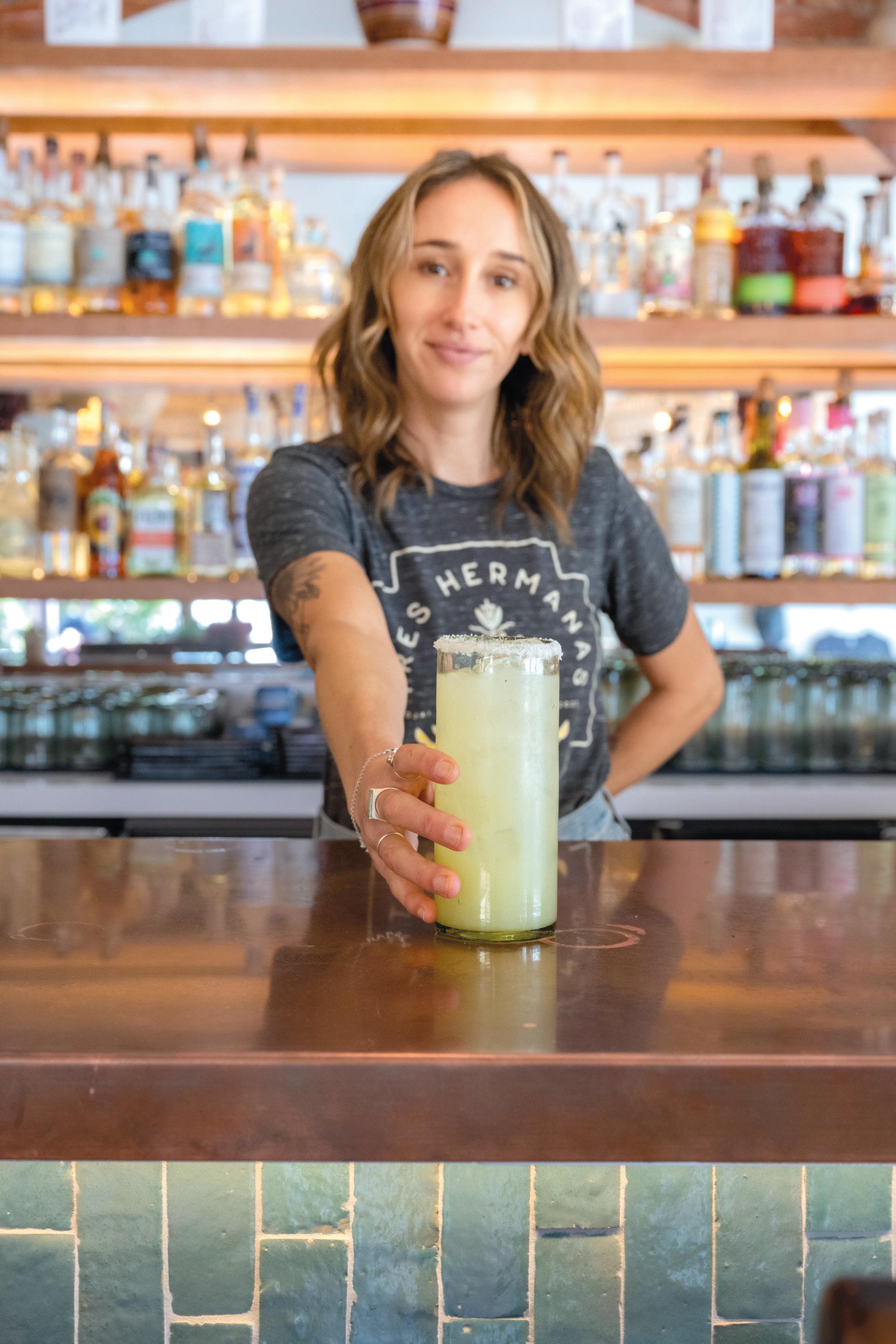
that’s all chased down with the heat-taming crème sauce. With such a lovely introduction to the gustatory pleasures here, we are looking forward to coming back for dinner.
During the year that Will Withrow spent developing the restaurant, a petition came out citing the restaurant name and menu as cultural appropriation of the ancient Indigenous practice of companion planting of corn, beans and squash. Miles is appreciative of the concerns and takes each one to heart. She credits much of the cuisine to the various cultures that led to the creation of the menu. She is letting the menu speak for itself—an appreciation of all cultures celebrating and merging their various experiences.
10 FALL 2023 Edible Ojai & Ventura County
Photos courtesy of Tres Hermanas





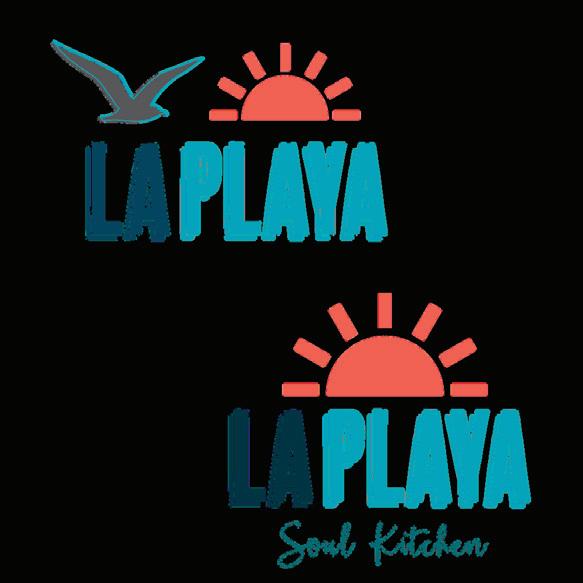




FALL 2023 11 EdibleVenturaCounty.com Quality Healthcare Starts with Clinicas. VENTURA LOCATIONS NEAR YOU clinicas.org/care 419 E. Port Hueneme Rd. Port Hueneme, CA | 805-874-1177 www.laplayasoul.com Follow us on Instagram @laplayasoul Experience Southern-inspired dishes with California's freshest ingredients, infused with Mexican spices. Try our daily hand-crafted biscuits and indulge in traditional espresso or specialty lattes. Wake up with SoCal Soul P O S E I D O N B R E W I N G C O C O M | @ P O S E I D O N B R E W I N G C O | 8 0 5 4 7 7 0 2 3 9
Modern Kitchen
30768 Russell Ranch Rd. | Westlake Village
Vibe: Easy elegance in a bright open space, and a patio with chandeliers.
Modern Kitchen owner Vincent Pillard says they’ve lightened up the walls and opened up the space in the Shoppes at Westlake Village spot that formerly housed The Gallery Restaurant.
“Before, it was dark. We’ve added wood and created a clean look,” says the entrepreneur, who also owns SLATE: Steak, Sushi and Cocktails in Camarillo.
Modern Kitchen will borrow from Slate’s emphasis on steak and liquor before finding its own niche, he says. “Modern Kitchen guests are more wine-forward. We’re looking for a good balance here of wines to cocktails, and steaks to other food that we have in Camarillo. We’re trying to spot trends beforehand.”
Pillard, who by his own admission loves to eat and try new things, says he tries to keep his ingredients as local as possible, noting that his produce is local because it’s better, and his seafood is as fresh as is available.

Feros Ferio Winery
310 E. Ojai Ave. | Ojai
Vibe: One-man show offers a tutorial on wine and fierceness. Of all the places we visited, Feros Ferio Winery was my husband’s favorite. Owner Nigel Chisholm seemed taken aback at first by my husband’s complete and total lack of knowledge about wines, but he recovered quickly and sprang into action by offering a sip of a Pinot Gris/Chenin Blanc blend. Chisholm says he blends his wines to create a more European sensibility, effectively taming the “fruit forward” California wines.
“This is super clean, super fresh,” Chisholm says of the fruity white wine. Next up is a 2022 Rousay Pinot Rosé that is “hard to explain,” he says, before going on to explain: “It’s like a red berry melted gelato but without the sweetness.”
With each description, my husband is entranced. He is finally tasting wine and understanding what it’s about.
“Usually at tastings, they just put down a glass with the name and walk away,” says my husband.
Chisholm’s aim is to give everyone a relaxing and enjoyable experience. This is clear as he flits around his artfully decorated tasting room, engaging everyone. It’s like being at a party put on by an excellent host. No one is left out.

My husband leans in. He’d never felt this comfortable. Up next is a Cabernet/Grenache blend. Chisholm describes how the grapes were crushed together to make a “silky wine with tannins for a hot summer day.”
We learn that this isn’t Chisholm’s first Ojai venture, as he used to own The Village Jester and the Vine.
“I want to get rid of snobbish wine tasting,” he says as he shows us his family’s Scottish castle and their toothful boar family crest. “People are afraid to go to a wine tasting, afraid they’ll be judged. I’ve cut through that.”
12 FALL 2023 Edible Ojai & Ventura County
Photo courtesy of Feros Ferio Winery
Photo courtesy of Modern Kitchen









FALL 2023 13 EdibleVenturaCounty.com WEDNESDAYS MIDTOWN VENTURA Pacific View Mall 9:00am - 1:00pm Front West Parking Lot On Main Street THURSDAYS THOUSAND OAKS The Oaks Mall 12 noon - 5:00pm East End Parking Lot Wilbur Road SATURDAYS DOWNTOWN VENTURA NEW LOCATION!!! 8:30am - 12 noon 200 Block of Main Street “On the Street” SUNDAYS SANTA CLARITA College of the Canyons 8:30am - 12 noon Parking Lot 5 Rockwell Canyon Road Juicing Made Easy… www.vccfm.org WIC, CAL-FRESH/EBT & MARKET MATCH ACCEPTED HERE Follow our markets on Social Media by visiting our website at www.vccfm.org CONNECT WITH US: 805.529.6266 @vccfm @vccfm Get the Mobile Pass VisitOxnard.com/TacoTrail
Wildflower Winery
4517 Market St. Suite 7 | Ventura
Vibe: Hidden gem is a cozy family affair.
Thanks to Nigel Chisholm, we are armed with better questions at our final stop. While the wines at Fero Ferio were bold, the Wildflower wines offers a whole different point of view.
“I keep the alcohol content between 11% and 13% because I like my wines to be light and fresh,” says host Natalie Albertson as she pours an Albariño, a white wine she describes as having a grapefruit and apricot taste with a salinity that is drying like a red wine.” She also pours a 2022 Wheeze, which is almost purple and smells like blueberries. “This is light, like a Beaujolais Nouveau, and is made using carbonic anaerobic fermentation,” she says. “I use a lot of ancient techniques.”
Natalie and her husband, William, who fell in love with wine while living overseas for a few years, now make their wines behind the tasting room as their children, Cooper, 10, and Poppy, 7, busy themselves upstairs watching TV and doing their homework. Wildflower Winery is located off Market Street in Ventura’s industrial area, which has attracted a wide variety of tasting rooms. Before they opened here, Natalie Albertson was driving from Carpinteria to Los Angeles to deliver her wine. “Now everyone comes to me. It’s just nice to be here,” she says.
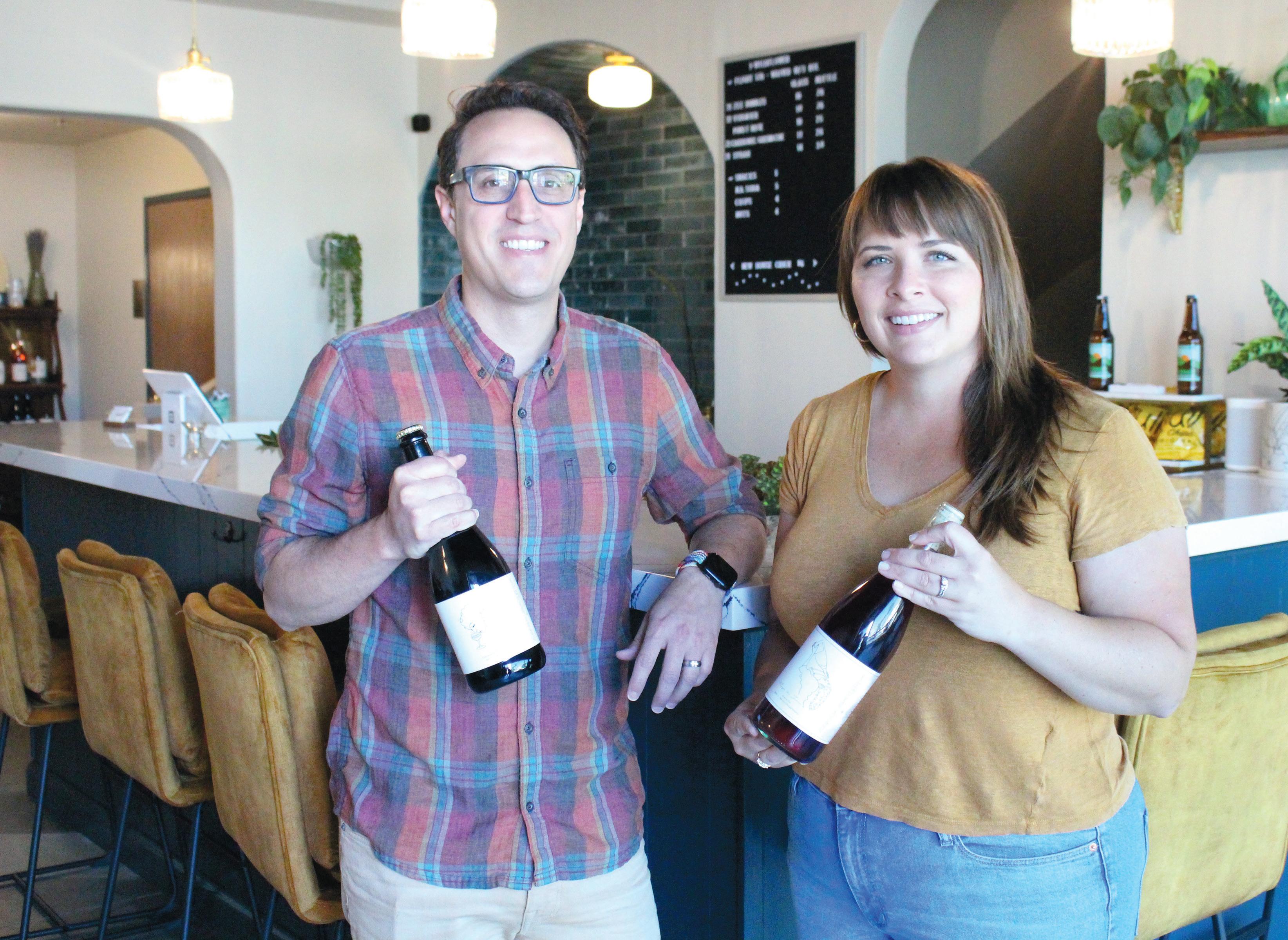
14 FALL 2023 Edible Ojai & Ventura County
Anne Kallas is a prolific freelance writer focusing on Ventura County. A fan of local, seasonal produce, she is the farmers’ market segment contributor for the LIVE 805 show on KVTA 1590AM. She lives in Ventura and is a former columnist, writer and copy editor for the Ventura County Star
Owners Natalie and William Albertson have created warm friendly vibe at the tasting room at Wildflower Winery, former home of Panero Bros. Winery, making it a stop worth adding to any Ventura wine tasting tour.
Photo by Tami Chu


FALL 2023 15 EdibleVenturaCounty.com




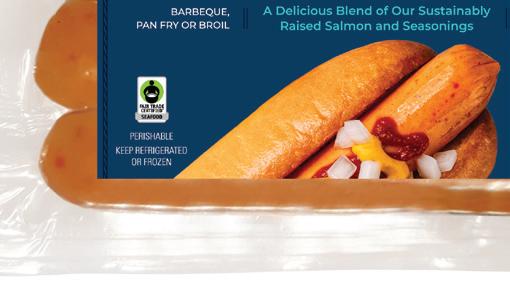
















16 FALL 2023 Edible Ojai & Ventura County Find Kvarøy’s salmon hot dogs in the frozen section of the fish and seafood department at Whole Foods Market. Find a store near you OUR SALMON HOT DOGS ARE DELICIOUS, HEALTHY, AND SUSTAINABLE IN EVERY BITE! Proud supporter of Can a HOT DOG CHANGE the World?
ABUNDANCE OF AVOCADOS
The tasty, versatile superfood all around us
WORDS AND PHOTOS BY LISA ROBINSON
In March 2001, the California Avocado Commission launched its annual ad campaign with a simple tagline: “So this is why people hug trees. Genuine California Avocados.” The fact that the avocado (which is considered a berry) needed an ad campaign at all perhaps shows that it has long been misunderstood. In the 22 years since then, avocados have continued to steadily gain popularity and find their way onto creative menus across the United States.
Most avocados produced in the U.S. are grown year-round in California, with Ventura and San Diego counties topping the list of highest avocado production. In the 2022 County of Ventura Crop & Livestock Report, avocados jumped from fifth to second highest-valued crop in the county, almost doubling from 2021. While they are generally a spring/summer fruit, some varieties are available into early fall as well. According to most sources, the most popular avocado variety commercially is Hass, a California native first planted in 1926 in La Habra Heights (near Anaheim). While consumers tend to favor it for its buttery, slightly nutty flavor and creamy texture, grocers appreciate its shelf life and sturdiness. While the Hass variety accounts for approximately 95% of the total number of avocados consumed in the U.S. each year, in Ventura County we have several hundred varieties. Among the more popular: Hass, Bacon, Fuerte, Zutano, Pinkerton, Reed and Gwen.
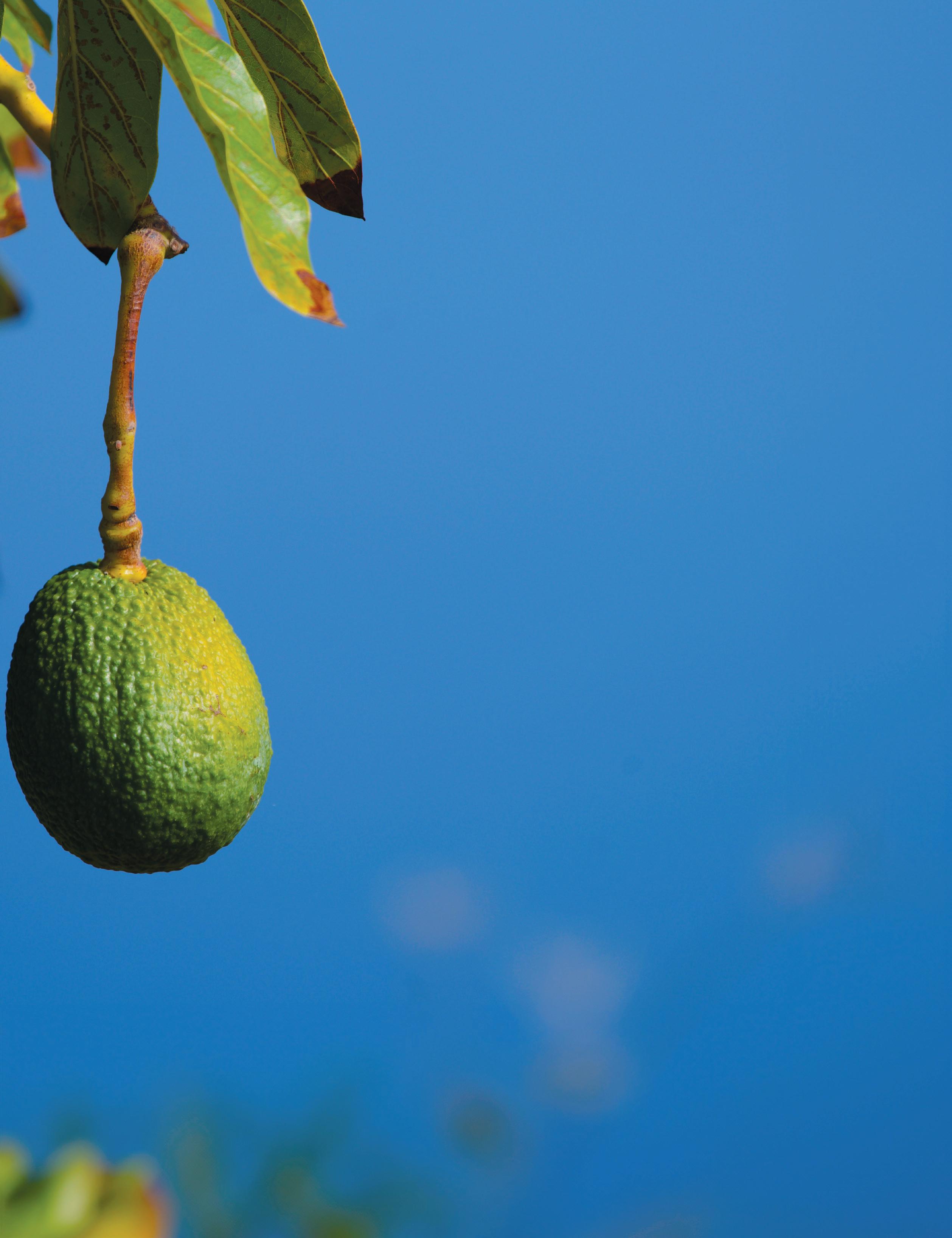
Check the local farmers’ markets for the varieties currently in season and ask the farmer about what kind they are growing! And for a throwback article on avocados on our website, check out the QR Code here.

Here are a few impressive reasons avocados are a superfood that should be incorporated into your diet as often as possible.
Nutrient Density: With only 80 calories, one serving of avocado (about 50 grams) provides almost 20 different vitamins and minerals. They are a great source of vitamins C, E, K and B6, as well as riboflavin, niacin, folate, pantothenic acid, potassium and magnesium.
Heart-Healthy Benefits: Avocados are packed with hearthealthy fats. Unlike other fruits, they’re low in carbs and high in fat. Over 75% of their fat is “good fat” that’s linked with healthier (HDL) cholesterol levels and a reduced risk of heart disease.
Blood Pressure & Blood Sugar Friendly: Potassium levels help counter sodium in the diet and reduce blood pressure. They’re also rich in inflammation-fighting compounds that promote healthier blood vessels and enhance blood flow throughout the body. Unlike other fruits, avocados don’t contain any sugar, and their healthy fats and fiber actually help to stabilize blood sugar and insulin levels, especially after a meal.
According to third-generation Santa Paula avocado growers Jason and Lindsey Cole of The Good Fat, avocados don’t ripen on the tree but instead begin to mature after picking, usually taking four to seven days to fully ripen. To speed up the ripening of your avocados, place them in a brown paper bag with an apple or banana. Close the bag and wait a couple days. Bananas and apples release natural ethylene gas that stimulates ripening. A perfect example of a superfood, avocados are a versatile, tasty addition to many delicious recipes. Here are three to try!
Lisa Robinson, a California native and graduate of Le Cordon Bleu College of Culinary Arts Pasadena, and University of California, Berkeley, is a full-time private chef in Montecito, a food stylist for various productions in Los Angeles, and she owns/operates LuLu Belle, a smallbatch locally sourced fruit jam, jelly and marmalade company in Ventura. You can find her on Instagram @lulubelleca. For private chef or jam inquiries, call 310-614-1230 or email lisarobinstone@gmail.com.
TASTES Like Fall
FALL 2
Pickled Avocados
If you find yourself with too many unripe avocados, these make a great puckery topper to salads, nachos/tacos, toast and cheese boards!
Makes 2 cups
1 pint-sized mason jar with tight fitting lid (a 20-ounce jar would also work)
2 avocados, medium size, firm to extra firm work best; not overly ripe
1 cup distilled white vinegar or apple cider vinegar
1 cup water
⅓ cup sugar
½ tablespoon salt
3 garlic cloves, peeled, whole or sliced
1 small shallot, thinly sliced
½ small lemon, seeded, thinly sliced
1 teaspoon red pepper flakes
1 tablespoon whole black peppercorns
Cut avocados in half, remove pits and peels, then slice lengthwise into thin strips, 5 to 6 slices per avocado half.
In a 1- or 2-quart heavy saucepan, combine the vinegar, water, sugar and salt. Bring to a boil over medium heat, stirring frequently. Once the sugar and salt have dissolved, turn off heat and set aside to cool.
Fill the mason jar with the garlic, shallot, lemon slices, red pepper flakes and peppercorns. Then put the avocado slices in the jar, pour the cooled pickling liquid over the avocados and close the jar tightly. Place in a fridge for at least 30 minutes, but ideally around 3 hours before eating.
Chef Notes: You can switch up the pickling spices to whatever you have on hand. Try whole juniper berries, bay leaves or sliced white or red onion. These quick avocado pickles need to be refrigerated and will last about 2 weeks.

18 FALL 2023 Edible Ojai & Ventura County



FALL 2023 19 EdibleVenturaCounty.com
Tuna-Stuffed Avocados
Tuna and avocados are perhaps unexpected bedfellows, but this savory combo is the perfect keto and gluten-free meal with well-balanced flavors and textures.
Serves 4
2 (6.7-ounce) jars tuna fillets in spring water, drained (7-ounce wild-caught dolphin safe canned tuna can be used)
2 green onions, thinly sliced
1 celery stalk, chopped
2½ tablespoons Italian parsley, finely chopped
2½ tablespoons mayonnaise
1 teaspoon soy sauce (for gluten-free, use tamari instead)

1 teaspoon Dijon mustard
1 teaspoon fresh lemon juice
¼ teaspoon freshly ground black pepper
1 pinch garlic powder
2 avocados, halved and seeded but skin on Optional for garnish: microgreens, green onion or fresh herbs
In a medium mixing bowl, add drained tuna, green onions, celery and parsley and stir gently to combine. Next, add mayonnaise, soy sauce, mustard, lemon juice, black pepper and garlic powder. Mix until all ingredients are incorporated. Scoop ½ cup of the tuna mixture into each avocado half. Garnish with microgreens, green onion or fresh herbs and serve immediately.
Editor’s Note: For children or those with less hand dexterity, an alternative way to serve this dish would be to peel and chop the avocados and toss them directly (and gently) into the tuna mixture. Serve on a leaf of romaine or butter lettuce.

20 FALL 2023 Edible Ojai & Ventura County

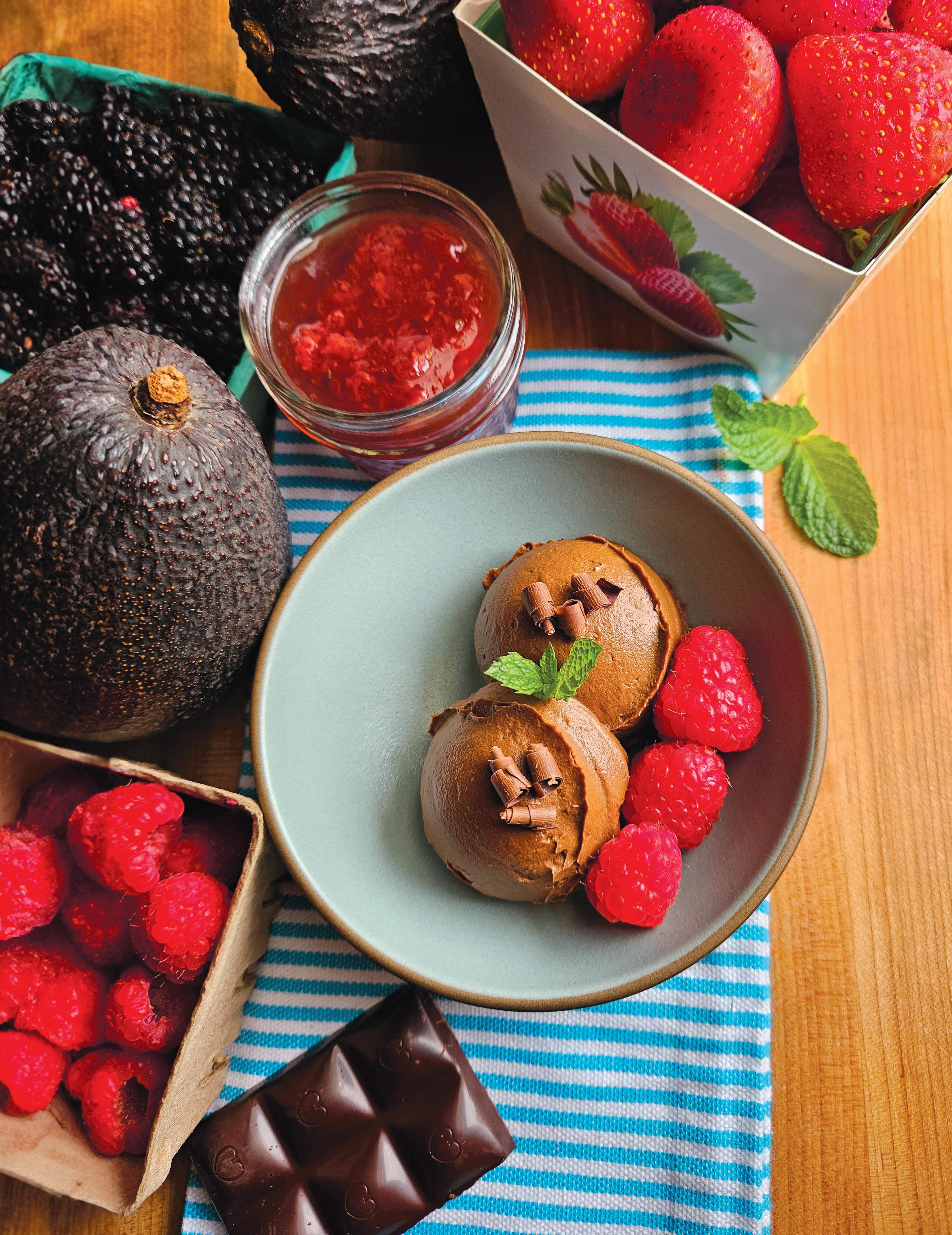
Chocolate Avocado Mousse with Homemade Strawberry Jam
Avocados are not just a savory treat. They can also be incorporated into delightful low-sugar desserts. Use this as an after-dinner sweet or a healthy snack throughout the day. The fats in the avocado are self-limiting: This dish can satisfy a chocolate craving without causing you to overeat.
Serves 4
½ cup chopped semisweet chocolate or dark chocolate chips, at least 60% dark
2 large ripe avocados, peeled and pitted
3 tablespoons unsweetened cocoa powder
¼ cup unsweetened almond milk

1 teaspoon pure vanilla extract
⅛ teaspoon kosher salt
1 tablespoon agave nectar, as needed
Optional garnishes: Homemade Strawberry Freezer Jam (recipe at right), whipped cream, toasted nuts and/or chocolate shavings
Place the chocolate chips in a small bowl fitted over a small saucepan of barely simmering water (or use a double broiler). Stir until the chocolate is melted and smooth, about 3 minutes. Set aside to cool.
Scoop the avocados into a high-powered blender or food processor fitted with a steel blade. Add the melted chocolate, cocoa powder, almond milk, vanilla extract and salt. Blend until very smooth and creamy, stopping to scrape down the bowl as needed. Taste and add up to a tablespoon of agave if additional sweetness is desired.
Spoon into ramekins and refrigerate until well chilled, 2 hours or overnight. Serve topped with strawberry jam, fresh raspberries, whipped cream, toasted nuts or chocolate shavings.
Homemade Strawberry Freezer Jam
This is one of the locally sourced jams I offer at LuLu Belle Ventura, so if buying jam is more your style, that can be arranged. Otherwise, this easy recipe keeps well in the fridge or freezer and is the perfect topping for avocado mousse, toast, PB&J or ice cream.
Makes about 2 cups
2½ cups fresh strawberries
¾ cup granulated sugar
Juice of 1 fresh-squeezed lemon
Wash the strawberries and remove the green stems, but don’t trim off the white parts; they are high in pectin, and will help the jam set.
Place the prepared strawberries, sugar and lemon juice in a 2½-quart heavy bottomed saucepan over high heat. Stir to combine and continue stirring until the mixture starts to bubble and strawberries are heated through.
Use a potato masher to mash the strawberries until they begin to fall apart. Mash as much or as little as desired; less for larger pieces of fruit in the end product.
As mixture begins to boil, continue to stir regularly, being careful not to let the berries burn.
Use an instant-read cooking thermometer to measure the temperature of the jam as it boils. Be sure the thermometer is measuring at the middle of the boiling jam and not touching the bottom of the pot. Continue boiling and stirring until the temperature reaches 220°F. This should take about 12–15 minutes. Remove from heat and carefully ladle hot jam into sterilized and dried ½-pint mason jars. The jam might seem a little bit thin at this stage, but don’t worry: It will thicken as it cools.
Add lids to the jars and allow to sit at room temperature until completely cooled.
This jam will keep for up to 2 weeks in the fridge or in the freezer for up to 6 months.
FALL 2023 23 EdibleVenturaCounty.com
Second Sweep!
Alex Montoya proves that he is the one to beat!
BY TRACY VALERI | PHOTOS BY VIKTOR BUDNIK

The award-winning Casa Pacifica Angels Wine, Food and Brew Festival was held on June 17. As in years past, hundreds of people reveled in music while tasting exquisite food and drink samples from local restaurants, caterers, bakeries, wineries and breweries. All proceeds from the event benefit Casa Pacifica, a nonprofit that meets needs for young people and families in Ventura, Santa Barbara and surrounding counties through community-based services like mental health support, education, therapeutic services and mobile crisis response.

For the second year in row, the first-place winner in both the Savory and Sweet categories was Chef Alex Montoya, executive chef at Honey Cup Coffeehouse and Creamery (four locations) and at Water’s Edge Restaurant and


Bar in Ventura and Waterside Restaurant & Wine Bar in Channel Islands Harbor. This year, Alex’s Savory winner was Water’s Edge “Shrimp Lumpia” with Szechuan ponzu foam, pickled red onions pearls and cilantro. His Sweet winner was Honey Cup’s “Al Pastor Ice Cream” Guajillo chai ice cream with grilled pineapple and honey cilantro pearls. He also captured the number one spot in 2021 in the Sweet category. After all of these wins, it seems Alex’s talent is taking beautiful, fresh ingredients and twisting them into creative, bold and seemingly nonsensical dishes. He says, for example, “When you hear ‘al pastor ice cream,’ it takes you from feeling that it’s off-putting to totally making sense. I like to create a conversation before I ever get to talk to you. It challenges me and I love that competitive aspect.”
In addition to focusing on the thought-provoking aspect of his food, analyzing, preparing and planning seem to be this chef’s creative catharsis and maybe even the secret to his repeated success. “At the event, I may not show it on the outside, but I am very hyped up and amped up on the inside. I am already thinking about what I want to serve next year based on what I learned this year.”
Edible Ojai & Ventura County
SPONSORED
From left: Chef Alex Montoya (winner), with Chef Damian Gilberti; Jackie Rome; Phil Adler; and Chef Danielle Saleh. Alex Montoya’s winning entries were Al Pastor Ice Cream (top of page) and Shrimp Lumpia (lower left).
Other 2023 Winners
SAVORY
2nd Place –Phil Adler

Freda’s Pizza and Woodfired Kitchen
“El Diablo” Pizza with calabrese, house pickled fresno chilis, Fior di latte (fresh mozzarella), basil, parmigiana, basil, hot honey.

3rd Place –Chef Danielle Saleh

Onyx Bistro
“Wild Mushroom
Gemelli,” a plantbased Asian Italian Fusion dish with a cashew miso cream sauce, sautéed wild mushrooms, scallions and sesame seeds.

SWEET
2nd Place –Chef Damien Giliberti, Ox & Ocean


“Cheesecake Pudding” with Harry’s Berries, lemon curd and sugar cookie crumb
3rd Place –Jackie Rome

Cocoa Rome
Chocolate Company
“Wild Strawberry Chip” wild strawberry ganache infused with micro chocolate chips surrounded in luscious 73% dark chocolate ethically sourced from Venezuelan cocao farms
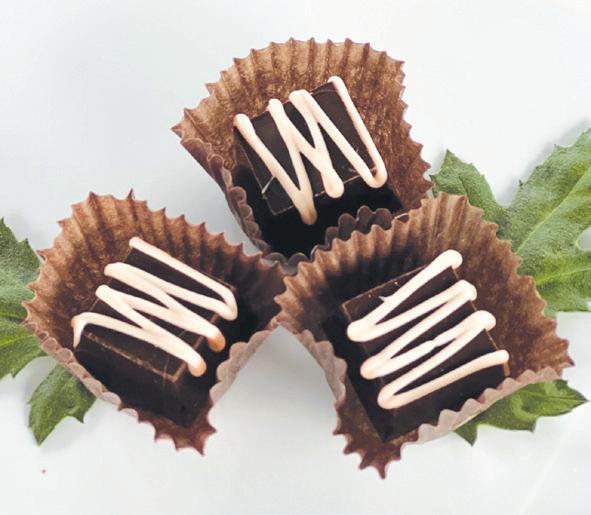
Since he spends 90+ hours a week in kitchens, Alex doesn’t often cook for his family because, well, they just don’t allow it. But in the rare times he does cook outside of the restaurants, he says he likes to cook dishes that are comforting and nostalgic. “I like meat and potatoes. I eat a lot of steaks and things I know I can make in an hour or two and it will last for about a week. And then I share it with my family, the way my grandma did.”
When asked what he values the most, he says it’s not winning contests. “My work ethic is the most important thing to me; I don’t want it to be overshadowed by rewards and awards. I didn’t go culinary school so I try not to let these accolades overshadow the hard work it has taken.”
Originally, Alex went to school to be an architect. Back when he was working as a dishwasher, his goal was to finish school and travel the world with the Peace Corps to make a positive impact on people. But when he became a sous chef, he says he realized he was already making a difference to the people around him and it stuck.

When asked for his advice for other aspiring chefs sweating away in the back of a kitchen, Alex says, “Failures are going to happen and they are life lessons. You have to experience them to get to where you want to go.”

Alex’s dream achievement is to get a Michelin star. “Even though people laugh it off, that gives me a stubbornness. Any failure along the way is necessary to get to where you want to be.”
Tracy Valeri lives in Simi Valley with her family and her dog, Henry. When she is not busy working as a project manager with Bank of America, she enjoys walking her dog, cooking for her family and drinking good wine.


FALL 2023 25 EdibleVenturaCounty.com
Every year, the Yummie Culinary Competition at the festival is judged by a panel of esteemed culinary leaders and experts. This year the judges included those below.
From left: Chef Abu Romero (Birnam Wood Country Club), Chef Karl Holst (private chef), Chef Eric Kopelow (vice president, CedarLane Natural Foods, Inc.), Chef Michelle Hernandez (Chefs on a Mission)
From left: Chef Masa Shimakawa (SOKO Chef, Fairmont Miramar Hotel & Bungalows), Alison Costa (owner, Ventura Food Tours), Chef Nic Manocchio (University Auxiliary Services, CSUCI) and Chef Adam Hart (Culinary Arts Instructor, Sommelier, Oxnard College.)
AN APPETITE FOR LEARNING
BY JENNIFER RICHARDSON | PHOTOS BY LISA MCKINNON
Chef Adam Hart’s culinary program students get to work in a real-life restaurant setting as they cook and serve at Oxnard College’s Bistro, which opened again in late August.
Mocktail Hour at the Oxnard College Bistro.

EDIBLE Influencer
Opposite:
Chef Adam Hart has a problem: He can’t stop learning new things and earning credentials to prove it.

Chef Hart runs the culinary program at Oxnard College, and I first noticed the issue on his online profile for Ventura County Community College District, which lists a bachelor’s degree in psychology, a Master of Business Administration (MBA) and an Associate of Occupational Studies (AOS) degree in culinary arts. It is a combination that struck me as both highly unusual and wildly applicable to the peculiar demands of the restaurant world. Still, his professional ambitions didn’t start in that realm.
Following college, where he obtained a bachelor of sciences in psychology from Chapman University, Hart worked at a nonprofit in San Francisco providing education for individuals with developmental disabilities. On the side, he started teaching classes in cooking, a hobby cultivated from time in the kitchen with his mother and grandmother. This eventually led him to apply to culinary school at the California Culinary Academy (CCA), where he says he, “fell in love with cooking.”
His realization that any restaurant needed commercial success as well as culinary success then led him to business school. There, he made a connection that took him back to the world of food—this time in a chef-instructor role. Landing the post surprised him, given his comparative lack of industry experience, and while he loved it, he eventually decided to move back to Los Angeles and get more time out of the classroom.
Hart did do restaurant work in Los Angeles but as would be fitting for a person who had thus far earned three degrees, he couldn’t stay away from education for long. He joined a nonprofit startup, the now-closed L.A. Kitchen, as director of education. Founded by Robert Egger and with a board that included World Central Kitchen founder and chef José Andrés and Tender Greens executive chair and founder Erik Oberholtzer, the idea at L.A. Kitchen was to build a culinary training program for people coming out of incarceration and aging out of the foster care system while providing food for the elderly.
Reflecting on this period at L.A. Kitchen, Hart says, “It was a really beautiful time being able to work in that sector and really feel like you’re helping people. I didn’t get that feeling again until I came here [Oxnard College] because the demographic here is different than the demographic when I was teaching at Le Cordon Bleu—significantly different.”
Students in the Oxnard College program are both young and old, including some who are previously retired, with demographics Hart likens to those of the city of Oxnard. But more than demographics, Hart describes the difference as coming down to one word: passion. The “students have a drive ... they didn’t just see a commercial and want to give it a try.”
To back up, Hart’s extensive resumé also includes a chef-instructor role at the Pasadena campus of the storied Le Cordon Bleu culinary program. When Le Cordon Bleu shut down in 2016, Hart made the leap to his current role at Oxnard College, bringing several Le Cordon Bleu instructors with him.
At Oxnard College, Hart has brought the full breadth of his education to inform the culinary arts program’s curriculum. “We’re going to do the industry-specific business stuff: We’re going to do SWOT [strength, weakness, opportunity, threat] analysis and food cost percentages. But we’re also going to spend a few weeks talking about different personality types and how to deal with them in the kitchen.” Cue Hart’s psychology degree.
During COVID restrictions, Hart’s own psychology—namely his tenacity with Sacramento and filing paperwork—helped keep the program running while much of the education system shut down. Lectures went online but labs remained in-person.
“The rest of the industry was out there working. We were training for the industry. There shouldn’t be that hypocrisy where we are training you to work in the industry, but we need to shut down.”
CONTINUED ON PAGE 30
FALL 2023 27 EdibleVenturaCounty.com
A Fall Menu from The Bistro
These recipes from Chef Adam Hart are examples of what might show up on a fall menu at the Bistro at Oxnard College. Made with simple ingredients and employing a variety of cooking techniques, they deliver big, delicious flavors.
SALTIMBOCCA
Serves 4
4 thin pork cutlets (chicken breast will work, too)
½ teaspoon freshly ground black pepper
8 medium-size fresh sage leaves (plus more for garnish)
4 large, thin slices prosciutto (about 4 ounces total)
¼ cup all-purpose flour (or 1:1 gluten-free flour)
1 tablespoon butter, divided
1 tablespoon olive oil
¼ cup Marsala wine (or dry white wine)
Lemon wedges, for serving*
Arrange the pork cutlets on a work surface between sheets of plastic wrap. Using a meat mallet or heavy pot, pound gently until each cutlet is about ¼ inch thick, making sure not to tear the meat. Remove the plastic wrap and season the cutlets on both sides with pepper and then lay them flat on the bottom piece of plastic wrap. Top each with 2 sage leaves and gently press 1 slice of prosciutto against the meat to adhere, folding any excess around the other side. Cover with the top piece of plastic wrap and gently pound the prosciutto into the pork so it sticks and holds down the sage. Place flour on a large plate. Delicately dredge both sides of the cutlets, shaking to remove any excess flour. Set aside.
In a large skillet over medium heat, add ½ tablespoon of the butter and the olive oil. As the butter begins to sizzle and turn slightly golden, add the cutlets, prosciutto side down, and fry until that side is crisp. Flip and cook until second side is lightly browned, about 1–2 minutes per side. Transfer cooked cutlets to a plate and cover with foil to keep warm.
Stir wine into pan, scraping up any brown bits from the bottom. Simmer until wine is reduced by half, about 30–45 seconds. Add a pinch of salt and whisk in the remaining butter until the sauce is rich and glossy.
To serve family style, arrange cutlets on a platter, prosciutto side up. Pour the sauce over the top, garnish with remaining fresh sage leaves and serve with lemon wedges*. Alternately, plate the meal on four separate dishes with broccolini and carrot purée.

*Chef Note: To elevate the recipe, cut the lemon in half and sear its flat sides on a hot pan or grill for a few minutes to caramelize. Cut into wedges and serve with the dish.
SAUTÉED BROCCOLINI WITH PARMESAN CHEESE
Serves 4
2 tablespoons olive oil
1 bunch broccolini
2 cloves garlic, finely minced Kosher salt
Red pepper flakes
¼ cup water
Grated parmesan cheese
Heat olive oil in a heavy-bottom skillet over medium heat. When oil is hot, add broccolini and garlic and season with salt and red pepper flakes to taste. Toss with tongs and cook uncovered for 3–5 minutes, until broccolini begins to brighten in color.
Reduce heat to medium-low and carefully pour in ¼ cup water. Immediately cover with a lid and cook for about 3 more minutes, or until the broccoli is bright green and cooked through yet still slightly crunchy.
Remove from heat, season with a little more salt and sprinkle with parmesan cheese.
A drizzle of good olive oil and a sprinkle of juice from a seared lemon wedge will pull all flavors of the dish together.
Photos by Tami Chu
CARROT & BROWNED BUTTER PURÉE

Serves 4
4 cups peeled and thinly sliced carrots
¼ cup unsalted butter
¼ cup cream
Salt and pepper, to taste
In a saucepan of lightly salted boiling water, cook carrots until very tender, 25 to 30 minutes. Drain; transfer to a blender or food processor.
In small skillet, melt butter over medium heat. Cook, swirling frequently, until butter is nutty brown and fragrant, about 5 minutes. Pour butter over carrots, then purée. Once there are no chunks remaining and mixture is smooth, pour purée into a bowl. Add cream slowly while stirring by hand. Add a little warm water if mixture is too thick. (You are looking for a consistency between mashed potatoes and soup.) Season to taste with salt and pepper. Serve in a bowl for family style, or plate it with the pork and broccolini using one of the purée plating styles at right.
Chef’s Note: To serve with the pork cutlets, make ahead and keep bowl in a just warm oven (150°F) while preparing the meat and broccolini.
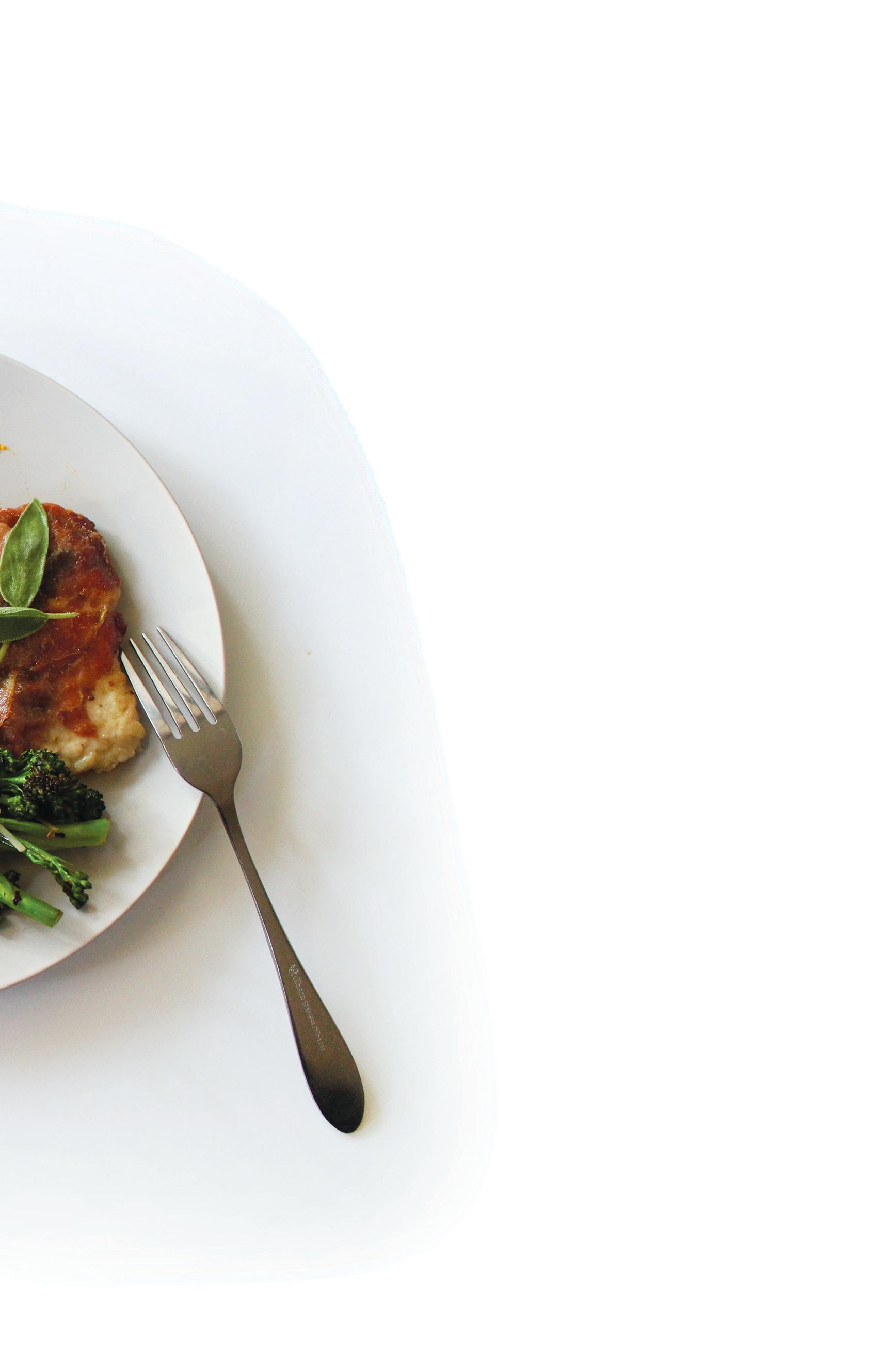
How to Plate a Purée
BY CHEF ADAM HART
1 The standard drag is the technique used most often in kitchens. It can be placed in any part of a plate and made any length. I’d say it’s the most versatile technique and adds a lot of drama to the plating. Add a dollop of purée and with the back of a spoon drag quickly in the direction you want the tail to point.
2 This is a more dramatic variation that would be used when most of your ingredients are straight, such as asparagus.
3 Here’s a technique used for plating something in the center of a dish, for example a filet mignon.
4 This easy technique adds a fine-dining feel, and is most often used when multiple components are present on the plate. Add a purée to a piping bag (or zip-top bag with the corner cut off) and add dots anywhere to help balance the plate.
5 Comprised of many “swoosh” style drags, this technique adds more linear drama. This would also be used to plate something in the middle of the dish. Although similar in style to #2, it adds more texture.
All are great techniques, but keeping it simple is always a plus in a kitchen. Speed and consistency are key in fine dining.
FALL 2023 29 EdibleVenturaCounty.com
1 2 3 4 5
Even as COVID kept him busy trying to reduce its disruption of the program, Hart cites pandemic boredom (and a passion for wine studies) to explain why he undertook the daunting process of certifying as a sommelier through the Court of Master Sommeliers during this same period. He and his wife were also expecting their second daughter, and he figured it was then or never.
True to form, Hart has drawn on his sommelier certification and built an Introduction to Wine course for the Fall 2023 term. It is the first time the college has offered a wine course of any kind, and he sees it as opening the door for students to work in industries prevalent in Ventura and Santa Barbara counties, including wineries, distilleries and their associated tasting rooms and kitchens. Recognizing the course may also be of interest to the broader community, it is held on a Monday night and has no prerequisites, other than a minimum age of 21.
In the least surprising moment of our interview, Hart let slip that the arrival of his second daughter didn’t dampen his habit of following his curiosity to a certified level of expertise. He earned a Wine & Spirt Education Trust
(WSET) Level One Award in sake following her birth, and he plans to bring this experience into the college’s gourmet and wine classes. (See page 32 for Hart’s article sharing his expertise on sake.)

The public can also partake in the bounty of Hart’s knowledge and his students’ skills by dining in the on-campus bistro, which is run by students and staff as part of the college’s culinary program. After a lunch-service-only offering in the spring, the bistro switches to a Thursday night dinner service this fall.
Hart is enthusiastic about the symbiotic relationship between the bistro and the public, whose patronage allows students to get hands-on experience in a restaurant setting while the community gets a delicious meal for excellent value.
“The relationship between our students, this dining room and the wonderful people of Ventura who come out of their way after work or whenever—that is really something. ... It is really beautiful what this community does for us.”
And Hart is equally proud of his students. Asked about some success stories from the college’s culinary program, he shares two quite different examples. One is Chris McConathy, who, after a lengthy career in the insurance industry, enrolled in the Oxnard program, went on to work at the esteemed Ojai Valley Inn, and now runs her own catering business, Olive2Cook.
The other is an unnamed student who didn’t pursue cooking professionally, but instead uses their experience from the program to prepare meals for their aging family. Hart wells up as he recounts this student’s feedback that “I get to cook for my family the stuff that I was taught here, and I really appreciate that, and my family appreciates it.”
Like Hart, both students are using education to enrich the lives of others, each in their own unique and valuable way. His students are also finding success not just at restaurants and hotels but also preparing food at assisted living facilities and in grocery stores, the latter of which tend to have more sustainable work hours.
“You don’t realize how many different avenues there are in this industry,” Hart says. He has the conviction of a man who knows this firsthand—and the credentials to prove it.
Jennifer Richardson is the author of Americashire: A Field Guide to a Marriage, an Indie Reader Discovery Award winner for travel writing. She and her British husband consider themselves lucky to call both Ventura and a village in the English Cotswolds home. To learn more, visit JenniferRichardson.net.
30 FALL 2023
CONTINUED FROM PAGE 27
Hart is enthusiastic about the symbiotic relationship between the bistro and the public, whose patronage allows students to get hands-on experience in a restaurant setting while the community gets a delicious meal for excellent value.
LEARN ABOUT the culinary arts, restaurant management and hospitality management classes at Oxnard College at OxnardCollege.edu/departments/academic/culinaryartsrestaurant-management
BOOK A TABLE at the bistro by emailing ocbistro@vcccd.edu.
POP IN AT CORK IT OVER, the wine and sake consulting service Hart runs in his spare time at CorkItOver.com.
BELLY UP at Cork Dork, one of Hart’s Ventura County restaurant recommendations and an employer of some of the program’s students at CorkDorkWineBar.com
OLIVE2COOK is a venture run by a former student in the Oxnard College program: Yelp.com/biz/Olive2Cook-Cateringand-Baking-ventura.
PORTO’S BAKERY & CAFÉ is a favorite of Hart’s and an employer of some of the program’s students PortosBakery.com.
RELAX and THANK Ventura Townhouse, a retirement community that has gifted stipends to the culinary program to help cover students’ incidental expenses and employs some of the students. VenturaTownehouse.com
NO-CHURN COFFEE ICE CREAM

By
Chef Adam Hart
Serves 4
1¼ cups heavy or double cream, well-chilled ⅔ cup sweetened condensed milk
2 tablespoons instant espresso powder
2 tablespoons espresso liqueur
Using a hand mixer or a stand mixer fitted with a whisk attachment, whisk all the ingredients together just until the whisk leaves trails of soft peaks in the bowl and you have a gorgeous, caffe-latte-colored airy mixture.
Pour into 2 (1-pint) airtight containers, and freeze for 6 hours, or overnight. Serve straight from the freezer.
Sake Primer

Ancient rice wines hold a world of flavors and tradition
BY ADAM HART | ILLUSTRATIONS BY ADRIEL CHU
When I was in college, sake was a drink served in a shot glass at sushi restaurants, and it may or may not have been suspended with chopsticks above a Japanese beer. You pounded the table to release the wooden suspension and chugged it.
This, my friends, is not the real sake experience.
I say this as a sommelier who was so taken by sake that I pursued a Level 1 sake certification. While studying the age-old spirit, I realized sake is misunderstood in the U.S., and the sake-making process is both more complex and simpler than winemaking.

What is sake?
Simply put, sake is a Japanese alcoholic beverage made from just four ingredients: steamed white rice, kogi (fermented cooked rice or soybeans), yeast and water.
All alcoholic drinks have been through a fermentation process, where sugar is converted into alcohol. With wine, the grapes have everything needed for fermentation including the sugar; however, rice does not. This is where kogi comes in. Kogi is a magical mold that contains an enzyme that converts the carbohydrates to sugar. Meaning sake doesn’t need additional sugar to ferment.
Generally, sake is anywhere between 15% and 17% alcohol by volume (ABV), much more comparable to wine than to the tequila or whiskey you might expect in that falling shot glass I described earlier. (To put that into perspective, a California Cabernet can easily be 14% to 15%.)
How is sake made?
Without getting wonky about the sake-making process, which predates most other alcohol production, sake starts with polishing 100% to 50% of the rice. (The more the rice has been polished, the lower the ABV.)
The rice is washed, soaked and steamed, the same way you’d make sushi rice at home. After the rice has cooled, the kogi is added to a fermentation tank with the water and yeast.
Nearly all of sake’s aroma comes from the yeast strain that is added to the fermentation process. This can be a hyper-local yeast (naturally occurring in the air around the vats), or one that is purchased and is more refined, stable and consistent.
Now choices are made, depending on the style of sake. Will the sake be filtered? Will distilled alcohol be added? Or water to decrease the percent of alcohol? Will it be pasteurized?
How do you drink sake?
This depends on how traditional you want to be. The most traditional way is with a masu, Japanese for “small box”; historically, masu were used for measuring rice, but they were also used for ceremonial occasions. Today, sake can be served in wine glasses (a tulip shape helps enhance the aromas). At home, I drink sake from a wine glass or, if I feel fancy, from a two-ounce wooden vessel.
Unlike most wines, with sake you have the luxury of enjoying it at different temperatures, and who doesn’t love that? So I encourage you to have a glass of chilled sake in the summer, and a glass of warmed sake in the winter.
Adam Hart is the lead instructor in the Oxnard College Culinary Arts, Restaurant Management, & Hospitality Management program. He has a degree in culinary arts from the California Culinary Academy and an MBA in sustainable management from Argosy University. He is also a Level 1 sommelier and has a Level 1 award in sake. To learn more about sake, he recommends the Level 1 award in sake through the Wine & Spirit Education Trust (WSET); flashcards are encouraged.
LIQUID Assets
JUNMAI AND HONJOZO
What it is: Rice is polished to 70% and has cereal and lactic aromas with more acid and umami taste. Junmai means “just rice,” and honjozo is essentially junmai with the addition of distilled alcohol. In Japan, junmai and honjozo (lower tier) are served more widely.

Serve: (no more than 122ºF)
Pair with: fish dish
Drink This In
You may be wondering how to pick a bottle of sake and know its characteristics. To help, Adam Hart created this handy sake cheat sheet with showing various types of sake and their best serving and food pairing ideas so you can find just the right sake to go with your meal. Also, don’t feel you need to spend a lot on a bottle. Hart says “cheap” sake isn’t bad quality; it just isn’t as refined as the more expensive styles. The bottom line is that sake, like any fermented beverage, is meant to be enjoyed, so don’t get too wrapped up in labels or processes. If you enjoy it, drink it!
JUNMAI GINJO AND GINJO
What it is: Rice is polished to 60% and has fruitier, more floral aromas. Ginjo, like honjozo, has distilled alcohol added.
Serve: chilled or room temp (if that is your preference).
Pair with: fresh vegetables and salads with higher-acid vinaigrettes.
JUNMAI DAIGINJO AND DAIGINJO
What it is: Rice is polished to 50% but retains the same fruity, floral aromas. Distilled alcohol is added to daiginjo.

Serve: chilled or room temp (if that is your preference).
Pair with: bleu cheese, gruyere cheese or Romano cheese.
NAMA-ZAKE
What it is: Unpasteurized sake.
Serve: chilled or room temp (if that is your preference).
Pair with: fois gras or other liver pâté.
NIGORI
What it is: Roughly filtered and can appear cloudy.
Serve: Best when chilled but can be warmed.
Pair with: spicy foods or sweet barbecue sauce.
Local Sake Stakeout
SPARKLING
What it is: Carbon dioxide is added to create bubbles.

Serve: chilled.
Pair with: fresh fruits and berries.
KOSHU
What it is: Must be aged more than three years and is sometimes caramel colored.
Serve: at room temp. Pair with: grilled fish.
For relatively low cost, you can pick up small bottles of different sakes from a local bulk liquor store to enjoy over time. Just remember that sake should be consumed within one week of opening and one year from its production date (unless it is koshu).
For a restaurant sake and food experience, Hart recommends Gotetsu (Gotetsu805.com/restaurant) in Ventura and Onyx at the Four Seasons (FourSeasons.com/WestlakeVillage) in Westlake Village. Both have a great selection of sakes and knowledgeable staff, he says.
FALL 2023 33 EdibleVenturaCounty.com
















34 FALL 2023 Edible Ojai & Ventura County 800-248-BUGS • 805-643-5407 • Ventura, CA rinconvitova.com Aphid Control Ant Control Fly Control Ventura Coffee and Dessert Bar with Handcrafted Botanical Gelato Organic Coffee, Lattes & Curated Cold-Brews Visit us at Portside Ventura Harbor 947 Schooner Dr Suite 105, Ventura, CA 93001 www.gelatokofibar.com | @gelatokofibar WE ARE OPEN! Come in for a free Single-Origin coffee tasting!
GETTING BEYOND THE BUZZWORDS
What is regenerative ag?
BY KIT STOLZ
At her Sow a Heart Farm in Fillmore, Mollie Englehart—farmer, vegan chef and mother of four—strolls around some of her 17 acres near the fast-flowing Sespe River and shows off her farm’s innovations in regenerative organic farming with a casual open-handed gesture. Sturdy cornstalks, already eight and nine feet tall in early July, shoot up between rows of avocado saplings, shading and protecting the fast-growing and delicate leaves of the shrubby young trees from the blazing afternoon sun. Running rampant on the ground between the corn and the trees are vigorous squash vines with enormous and spiky leaves, which deter weeds, protect the soil and discourage pests. Not far away can be found a rectangular pen made of livestock panel, which can be used as a small mobile corral in which to keep sheep focused on eating weeds.
Chicken tractors, combined with rotational grazing on pastureland is one way farmers can use animal husbandry regeneratively.
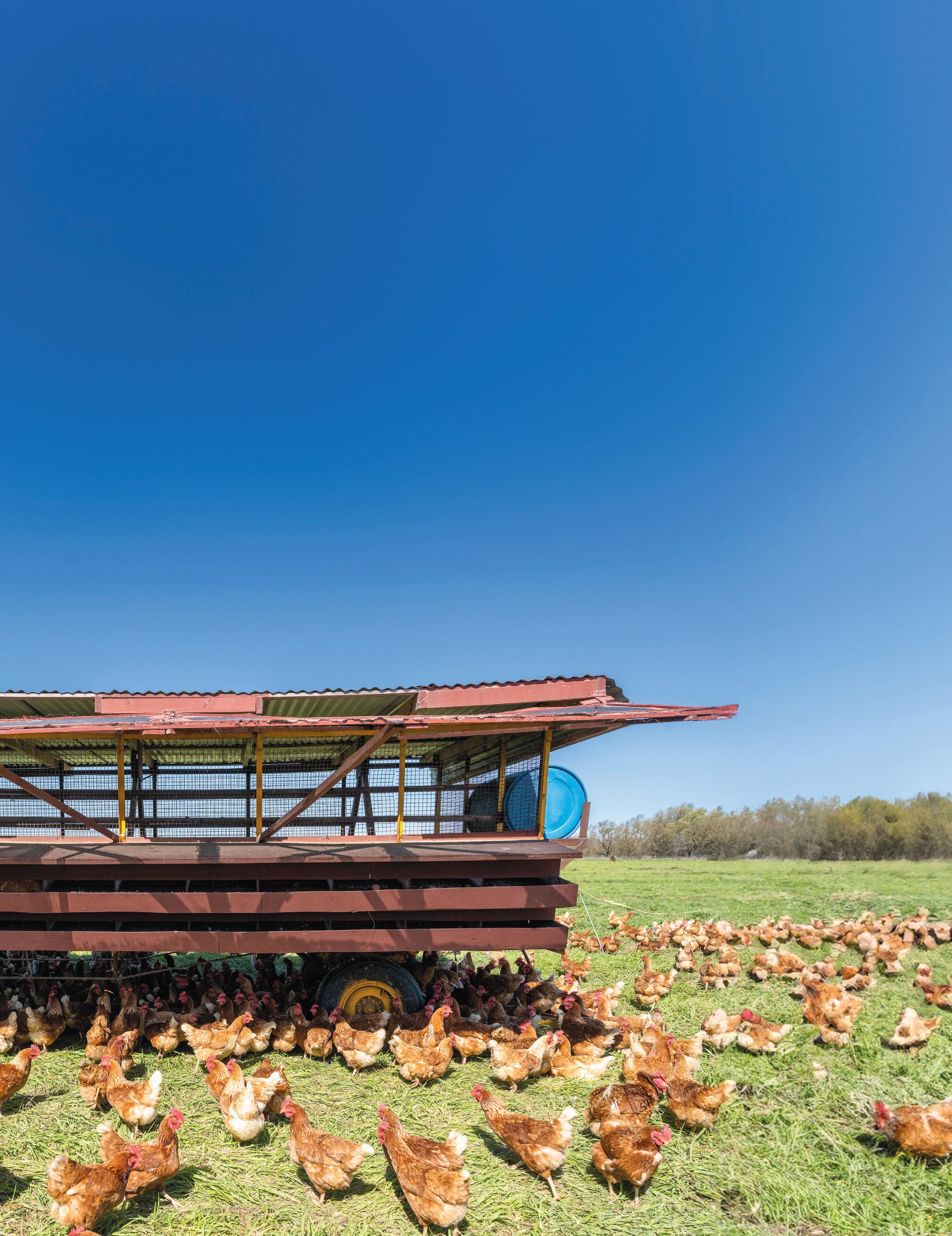
FIELD Notes
“ Twenty-five percent of the life of this planet lives in the top eight inches of soil. We must value that top eight inches of life in the soil as much as we value the polar bears on the ice caps or the tigers in the jungle, because that life in the soil may have a bigger impact than these larger species. It’s time for mankind to rebuild that life that we’ve been steadily destroying.”
—Mollie Englehart
The Engine of Regenerative Farming
Englehart’s belief in animal integration is essential here, because while well-established “organic” certification rules prohibit chemical pesticides or fertilizers, the newer “regenerative” certification standards call for increasing the amount of organic matter and microbiology in soil, in part by discouraging tilling or plowing.
Around the corner and closer to the river are a few cows in a corral, one of which comes over to affectionately muzzle Englehart’s hand when she stops nearby.
“This is Una,” Englehart says. “She was my first cow. I have a longstanding relationship with all my cows. They are also the engine of this farm.” She is speaking of the manure produced by animals and used to bring fertility to the land.
Englehart links the health of the soil to human health, pointing out an overlapping connection between the microbiology of the soil and the microbiome in the human gut.
“This kind of farm—with a few cows, a few goats, a few sheep and a wide diversity of crops—sounds like an antiquated idea,” she says, “but it’s regenerative organic agriculture and it’s the kind of farming that we’re trying to get back to. I haven’t bought any inputs to this farm in three years. I only buy hay, to feed the cows and to make compost.”
A Nature-Based Climate Solution
In 2019, Englehart agreed to be one of the first farms in Ventura County to pursue a Regenerative Organic Certificate (ROC), along with the famous Apricot Lane Farms in Moorpark (which was featured in the popular 2018 documentary film The Biggest Little Farm). Englehart is a believer in the power and promise of organically grown foods. When the Regenerative Organic Certification standards were first rolled out in a pilot program in 2019, she worked with long-time organic and regenerative farmer Phil McGrath, of McGrath Farms in Camarillo, and Regenerative Organic Alliance (ROA) representatives to go for a certification. She looked at the process as useful research for her soil work as a board member for the Kiss the Ground, a regenerative advocacy and documentary group based in Los Angeles.
“Kiss the Ground is in the forefront of soil health, and some of the work they have done—with cotton farmers, for instance, in Texas— has been amazing,” she says. “They used testing as part of an education program for farmers, in which the soil was tested for microbiology, and for more humus and more soil carbon content over time, using cover crops and no tilling. It’s less about the inputs to the land and more about the practices.”
Yet because a Regenerative Organic Certification is intended to build the underlying health of the soil, it’s not as straightforward to measure and regulate as checking for the chemical inputs prohibited in organic growing, she says.
David White, a biologist who co-founded a small nonprofit in Ojai in 2002, the Center for Regenerative Agriculture, explains why it’s more difficult to measure regenerative than organic growing practices.
What is Regenerative Ag?
It is a holistic approach to farming in the context of a farm’s unique systems and site-specific conditions, climate, and cultural practices in the region.
More specifically, from the ROA’s perspective: The Regenerative Organic Certified Framework upholds basic organic principles and is rooted in regenerative agricultural practices, providing an entire menu of options for farmers based on site-specific conditions.
Both the term regenerative agriculture and the practices that define it are not modern creations. The term was first introduced by Dr. George Washington Carver and was made most well-known by Robert Rodale of the Rodale Institute. Regenerative agriculture is a collection of practices that focuses on regenerating soil health and the full farm ecosystem. These practices come from traditional and Indigenous practices from throughout the globe and are a result of individuals farming as part of the natural system, not apart from it.
ALL the living beings in a community—from the farmers to the farm workers, farm animals, and soil microbes— must be valued. In other words, farming in service of LIFE.
 —Elizabeth Whitlow
—Elizabeth Whitlow
36 FALL 2023 Edible Ojai & Ventura County
Photos by Mariah Green
“Regenerative agriculture is a nature-based climate solution,” he says. “The plants are taking carbon out of the atmosphere and putting it into the soil. So they’re sequestering carbon, and the double whammy is that sequestering carbon in soil increases soil health. So, because you can put a number to the soil carbon content, it sounds as if it would be easy to send a sample to be tested for its soil carbon content, but in fact it’s a little confusing. Carbon can be in living or non-living forms, for one, and soil carbon content can vary a lot depending on where you sample it; and the first thing that laboratory testing routinely does is to dry soil samples out completely, which means the microbiology dies—and ultimately that’s what you’re trying to measure, the health of the soil.”

Elizabeth Whitlow is the executive director of the Regenerative Organic Alliance (ROA), which includes Dr. Bronner soaps, long-time organic advocates Rodale Institute, and Patagonia. It was through ROA that Ventura County regenerative organic farms were first certified. Like White, Whitlow also believes that regenerative agriculture is not as easy to regulate or test as organic. She thinks that’s especially true when it comes to practices involving farm animals such as cows and chickens.
“It’s all about traceability, with animal welfare,” Whitlow says. This means strictly tracking organic inputs and organically fed versus non-organically fed animals. She adds that some of existing industrial factory practices allow for painful “modifications” to farm animals, such as cutting the tails off pigs, or trimming chicken beaks. (Regen-
erative organic certification for farm animals, by contrast, requires that they be ensured the “Five Freedoms,” as defined by the American Society for the Prevention of Cruelty to Animals, including “freedom from pain, injury, or disease.”)
Getting Beyond the Buzzwords
Whitlow adds that because “regenerative” has become a buzzword that appeals to consumers and growers alike, huge producers such as Walmart and others have declared themselves to be adherents of regeneration without clearly defining it.
In 2020, Walmart announced that it was planning to devote 50 million acres towards regenerative growth. CEO Doug McMillon declared, “We want to go beyond sustainability to become a regenerative company dedicated to placing nature and humanity at the center of our business practices. Restore, renew, replenish,” he said, mentioning “aspirational goals to achieve 100% renewable energy, zero waste and a more sustainable supply chain.”
But as Whitlow points out, the vague claim of regenerative agriculture that Walmart has put forward is problematic in that it doesn’t require an organic certification as a prerequisite, raising questions about the seriousness of their commitment to clean foods and soil health.
“What does that even mean?” she wonders. “We’re mindful not to dilute this really potent term that gets people’s attention. I think what
FALL 2023 37 EdibleVenturaCounty.com
David White, co-founder of Ojai’s Center for Regenerative Agriculture, works on compost tea, one of his soil health experiments
Photo by Kim Stolz
really drives that interest is so much angst around climate change. People want to have something hopeful to grab on to, something that they can buy that feels right, something that’s grown in a way that’s healthy and speaks to their values.”
At Sow a Heart Farm and at her vegan restaurants, Mollie Englehart has built a business around growing and preparing healthy, organically and regeneratively grown foods (see QR code at the end of this article), but admits that she has become frustrated with the way agriculture is inspected.
“I’m not a fan of the current certifications,” she says. “I think they are not designed for the small farmer who grows diverse crops. I grow over 300 things. As a farmer I’m accustomed to organic regulations and as a chef I’m accustomed to health inspections in restaurants, but in the ROC there’s also an equity component, and so you have your organic inspection and your ROC inspection, and then you have to spend a whole separate day going over handbook and wage statements, looking for any discrepancies.”
Englehart is not alone. At Apricot Lane Farms in Moorpark, the farming couple in charge, John and Molly Chester, also chose to pursue a regenerative organic certification as part of the pilot program in 2019, but in time instead went for a different certification, for biodynamic agriculture. Like the regenerative organic standard, biodynamic farming requires organic certification as a prerequisite, but

offers an alternative model that incorporates animal husbandry and includes spiritual elements.
Whitlow admits it was painful for her, as executive director of the ROC program, when Apricot Lane Farms decided to pull out of the regenerative organic certification.
“I was disappointed,” she says. “But Apricot Lane Farms’ involvement in our pilot program helped inform edits, inspire updates and ultimately evolve the certification framework into the current version. This is the high bar of certifications and it’s an intensive process, especially with so many different types of workers.”
For Englehart, the labor audit part became a central issue.
“Because I own several farms and restaurants, I have an office staff,” she says. “But I could not comply with the requirements of the ROC on a farm of this size without it.”
Englehart stresses that she still believes that—as with organic standards—inspections are necessary to maintain standards in regenerative and organic agriculture.
“We need guardrails,” she says. “I think farmers are innovating faster than the regulators can keep up with, which is a weird situation, but we still need certifications because we don’t trust each other.”
Whitlow, who says she spent more than 25 years in the field of organic agriculture before coming to the Regenerative Organic Alliance, recognizes that the inspection process can be a challenge. She argues
38 FALL 2023 Edible Ojai & Ventura County
Photos by Mariah Green








FALL 2023 39 EdibleVenturaCounty.com Fresh Nuts, Dried Fruits & Candies Huge Selection of Gift Packs 4475 E. Los Angeles Ave., Somis 805-386-1211 • 800-266-NUTS Open 7 Days Tue–Sat, 10am–5pm 300 N. Lantana St. #37, Camarillo Tea-Liteful.com 805-445-8327 Call for reservations • European Tea Room • Over 130 Specialty Teas • Cream Tea, Afternoon Tea, High Tea • Bridal Showers, Baby Showers, Catering BellaCopper The Original Solid Copper Heat Diffuser, Defroster Plate & Oven Plate Copper conducts heat better! Made in Ventura, CA since 2002 www.BellaCopper.com edible Ojai & Ventura County Marketplace To join, contact us at info@edibleventuracounty.com EMPLOYMENT COUNSEL & LITIGATION | INTELLECTUAL PROPERTY Innovative | Experienced | Responsive info@lightgablerlaw.com | LightGablerLaw.com | 805.248.7208 Ignoring employee issues doesn’t make them go away.
that good record-keeping has benefits for the grower that can be realized over time, and also that it’s important to ensure that farm laborers, many of whom are undocumented at first, have to be protected from harassment or exploitation by contractors or farmers.

“For these reasons, we require labor contracts, and we need to see paychecks, and if the farmer provides housing, we need to inspect it,” Whitlow says. “Sometimes it’s awkward. I once inspected some farm labor housing and I filed a complaint about a dairy operator, because the housing was near stores of grain, and [the farm laborers’] houses were overrun with rats.” ROC requirements are that housing must meet local rental conditions ensuring a reasonable level of comfort, including sanitation, safety, ventilation and more.
At the Sow a Heart ranch in Fillmore, Englehart—who says she lost millions of dollars at her restaurants during the pandemic—has reluctantly decided to pull up stakes in Ventura County and move to Texas with her family to start over. She plans to open a “farm stay” business with her husband, featuring about two dozen Tiny Homes for accommodations, a brewery and a small restaurant for visitors. She will remain organic, and perhaps pursue a biodynamic certificate, but doubts she will return to regenerative organic certification.
Yet she remains as adamant as ever about the importance of soil health—in agriculture and in life.
“Twenty-five percent of the life of this planet lives in the top eight inches of soil,” she points out. “We must value that top eight inches of life in the soil as much as we value the polar bears on the ice caps or the tigers in the jungle, because that life in the soil may have a bigger impact than these larger species. It’s time for mankind to rebuild that life that we’ve been steadily destroying.”
Editor’s Note: The ROA, the certifying agency for Regenerative Organic Certification, recently announced a huge milestone achievement after less than five years: There is now one million acres of certified regenerative organic agricultural land globally. For perspective, after 32 years, only 3.6 million acres of land in the U.S. is USDA Certified Organic.

40 FALL 2023 Edible Ojai & Ventura County
A regenerative orchard at Rodale Institute’s Pocono Organics
Photo courtesy of ROA
Kit Stolz is an award-winning journalist who has written for newspapers, magazines, literary journals and online sites. He lives in Upper Ojai and blogs at AChangeInTheWind.com.
VENTURA'S PREMIER FOOD & WINE EXPERIENCE

Enjoy up to 40 wines by glass or bottle paired with the ever changing menu of small plates, pizzas, salads, and burgers created in our small kitchen.
www.thecaveventura.com @thecaveventura

The Cave Restaurant & Ventura Wine Company 4435 McGrath St, STE 301 Ventura, CA 93003


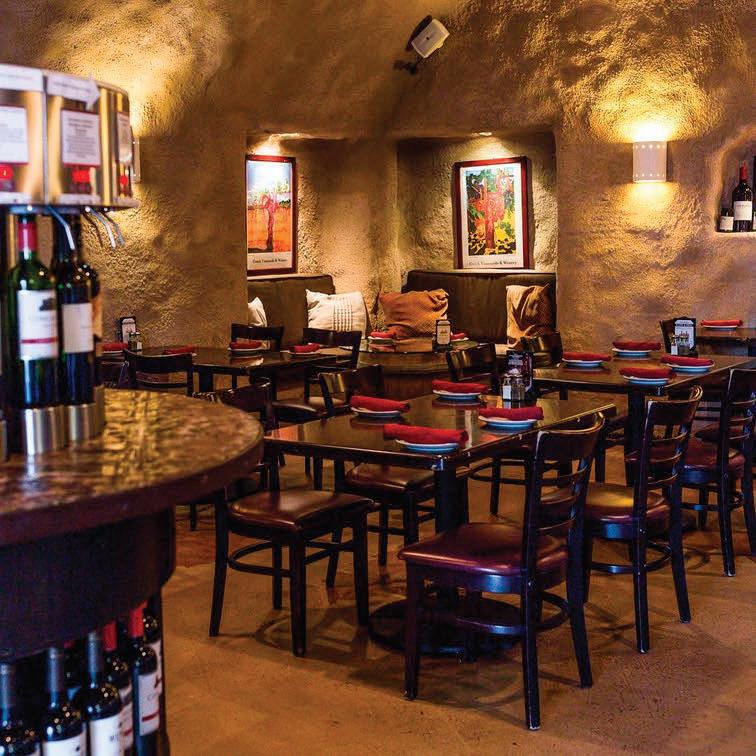
Ventura Wine Co. offers a wide selection, some very familiar, some hard to find and some gems that are waiting for you to discover.

Shop a selection of more than 1,000 local, domestic, and international wines, sparkling wines, champagne, and beer. LOCATED AT


4435 McGrath St, STE 301 Ventura, CA 93003
thecaveventura.com/venturawineco
FALL 2023 41 EdibleVenturaCounty.com
LEGACY of LECHE
Reconnecting to my Chilean heritage through recipes
BY CHRISTINA BERKE
“It’s really quite simple,” my abuelita says to me over a video call years ago. “Start with just a bit of sugar… ”
Through Wi-Fi glitches that froze or sped up or disconnected us altogether, I leaned in closely to hear my grandmother pass on the recipes she loved growing up, and still eats today, in Chile. It wasn’t always like this.


Growing up in the Conejo Valley, over 5,500 miles from Santiago, I felt disconnected from my maternal side because they lived so far away. There wasn’t a Chilean community here. At home, my mother cooked typical American foods to help her assimilate to her new
culture. I ate tofu and pasta and baked potatoes—white foods that became staples as I moved out and cooked in my own kitchen. Nowadays food imported from Chile is much more common: grapes and wine, even dulce de leche. Though the 805 has diversified its restaurant culture more over the years, in the 1990s the most common ethnic foods available were Mexican and Indian. But burritos and curries, delicious as they are, weren’t the same as humitas and bistec.
With every burger and each spaghetti dish, I felt like I was silently
FIRST Person
42 FALL 2023 Edible Ojai & Ventura County
choosing my paternal side, reinforcing their importance and muting my mother’s. A large part of my identity was erased. It wasn’t until I was older that I heard stories (or maybe I was just finally paying attention) about my mother’s family meals back home of cazuela, sopaipilla and desserts of sticky manjar blanco. I wanted to know more: What did these foods taste like? Boiled milk for dessert didn’t sound very appealing, honestly. It was time to reconnect with my heritage, one bite at a time.
In 2005, I went to Santiago to visit my family. My cousins took me out to cafecitos (little cafés) where I tried lucuma (a tropical fruit known as Gold of the Incas that is now considered a superfood) and tres leches with meringue and alfajores. My taste buds started to unlock core memories. With each lick and every bite, I realized I’d eaten these foods before. My cake when I turned 2 was a torta panqueque, something I hadn’t eaten since I spent my birthday there in South America all those years ago.

Back in California, when I started learning how to cook, I wanted to feel more connected to my family history through the sense of taste. Slowly I began, recipe by recipe, to cook into my heritage, first from my mother’s handwritten cookbook that she’d brought with her when she first immigrated here, then through recipes online, a Chilean cookbook, and finally to the original source: my 95-year-old grandmother.
Opening my mother’s cookbook was like watching a wobbly home video, peering into a time capsule to reveal what my mother ate as I carefully turned the crisp pages. The first thing I noticed was her handwriting, so different from what I knew hers to be now. Bubbly and bright, it told me she must have been in her teens when she recorded these recipes. I translated them from Spanish to English; from metric to U.S.; from hard-to-get items to readily available ones that could substitute.
The first dish I made was brazo de reina—a Swiss roll with manjar (a caramel similar to its popular sister, dulce de leche, made by boiling a can of condensed milk)—named for its resemblance to a queen’s arm. My mother knew the dough got sticky; that as soon as it was out of the oven, you had to roll it delicately to shape it with a cheesecloth even though it was so hot it burned your fingers; to moisten the dough with a touch of brandy.
I was so proud of my first Chilean dish, but nervous if it would taste anything like what my mother had grown up enjoying. After it cooled, I sprinkled powdered sugar on top, cut the roll and served it. The gooey golden manjar oozed out, spilling onto the plate. It looked messy. Had I put in too much?
“Well, let’s see,” I said tentatively. We grabbed our forks and dug in. The plates were scraped clean in minutes.

“¡Que rico!” my mother said. “This tastes just like I remember it.” With that, I passed my first kitchen test.
Next on my list of recipes to make was a typical ensalada chilena—fresh, peeled tomatoes with thinly sliced onions drizzled with oil and vinegar—a classic staple of my mother’s childhood. To go with it, empanadas, like mini sandwiches of my youth, stuffed with browned meat, sautéed onions, hard-boiled egg with bright yolks crumbling into the mix, black olives and the surprising burst of sweet raisins. The crisp golden thick crust folded over a pocket of the savory mixture, so piping hot the steam fogged my face like a humid day in Santiago.
FALL 2023 43 EdibleVenturaCounty.com
With each lick and every bite, I realized I’d eaten these foods before. My cake when I turned 2 was a torta panqueque, something I hadn’t eaten since I spent my birthday there in South America all those years ago.
My grandmother and I had started visiting weekly over video calls and I was excited to report my kitchen adventures. I showed her photos and described my dish, proudly stating that Mom gave her seal of approval.
“You’ll have to make it here for me one day, querida,” she said.
Soon I started asking her more—how accurate these published recipes were, and how she made her favorites, scrambling to write down the ones she knew by memory, trying to help her think of the name of the dish she was describing. Along with the measurements, I heard stories of love, friendship, and travel.
“Oye,” she said to me one day. “You know, I used to eat this with your grandfather when we went down to the farm.” He was the love of her life, and ever since he passed away a few years ago, eating foods that they enjoyed together evokes memories of 70 years of a joyful marriage.
Or sometimes: “You know yesterday I had the most incredible dish … But nothing is like the corvina I had at Pablo Neruda’s house …” She went on to share the parties she attended at the famous poet’s home, drinking pisco sours and lots of wine. While I couldn’t replicate a special stone oven with freshly caught seaside fish, I could find Chilean sea bass and put my own spin on it. Like looking at the same moon at night, I felt connected to her even through miles and countries apart.
My biggest ambition was to make my favorite cake: torta de mil hojas, or cake of a thousand layers, a dessert so rich, it’s sliced as thin as possible. But I was quickly deterred.

“It’s too labor-intensive,” my mother said. “And it won’t taste the same.”
Instead, I opted to make leche asada, a jiggly custard flan-like dish. To try to replicate it, my mother insisted, we had to get the best full-fat milk we could find. It wouldn’t be like the farm-fresh milk of her youth, still warm and frothy, but it would do.
“Is this right?” I asked my grandmother via video, tilting my phone near the saucepan.
“You have to cut open the vanilla first and scrape out the bean specks inside,” my grandmother taught me.
“And constantly monitor it so it doesn’t burn,” my mother added.
As I stirred the milk warming on the stovetop, memories stirred too. “Meme used to make this when we’d come home from school,” my mother said about her own grandmother. The power of this image, of her grandmother standing over the stove, wooden spoon scraping the pot, invoked my ancestors in a way I hadn’t been able to access before. I felt my emotions welling up. There is something sacred about consuming the same foods that my mother did, the foods that shaped her, that comforted her, that built her—and the generations of women before her.
Then came more traditional recipes over the seasons: mote con huesillo (dried peaches with wheatberries and spices), turrón de vino (whipped egg whites and wine), peras con vino (poached pears in wine), porotos granados (hearty bean and squash stew). I even attempt-
44 FALL 2023 Edible Ojai & Ventura County
The brazo de reina, translated “queen’s arm,” is a Chilean rolled cake traditionally filled with manjara—caramel made from sweetened condensed milk—and served as a snack in the afternoon.
ed pastel de choclo, a dish similar to shepherd’s pie with beef, raisins, chicken with merkén (a spice from the indigenous Mapuche people) and a mashed corn top baked to chewy, crunchy perfection. But there was a hiccup.
“The corn has to be fresh,” my mother said. She was used to eating seasonally growing up.
“Can’t I just use this?” I pulled out a bag of frozen corn.
“Por favor,” she rolled her eyes. Instead, I waited until summer for fresh corn from la feria (farmers’ market) to have the best chance at making one of her favorite comfort foods from her childhood.
Of course, not all of the ingredients could be exactly the same, and I didn’t get to share what I made with my abuelita to see if it tasted bueno, but it felt like a bridge between our two worlds through food. Eating the same dishes my grandmother ate as a child, as did my mother, felt like I was honoring our heritage one meal at a time. The dishes all felt sacred to me, special not in their ingredients but the stories behind them. The legacy of cooking over the stove.
Any time I miss my grandmother, I call or message her, or open up the recipe book and start cooking. Even something simple like pan con palta (avocado toast) is accessible and pretty hard to mess up. (My grandmother was eating avocado toast well before it became an overpriced staple on every trendy hipster menu.)
We sit on video call with our cafecito helado, my grandmother, my mother and me, three generations of women united through food and family. Recently we even found a small Chilean restaurant in the Valley, where looking at the menu made us nostalgic for the foods we associated with the motherland. On dieciocho (a Chilean holiday) we pick up a dozen, warm them in the oven at home, and let the smells take us back to the calles of casas a continent away.
WHAT’S GROWIN’ ON IN FALL
Broccoli Rabe
Burdock
Cabbage
Celery
Corn
Dates
Kiwi
Ginger
Green Beans
Jicama
Mandarins
Mangos
Persimmons
Pomegranates
Raspberries
Strawberries
Sweet Potatoes
Hard Squashes
Tomatoes
Walnuts
HERBS
Cilantro
Lemongrass
Oregano
Rosemary
Sage
Thyme
OTHER Eggs
Fresh Flowers
Honey
Olives, Olive Oil
Potted Plants
Preserves
FROM
THE SEA
Anchovies
Black Cod
Clams
Crabs
Halibut
Sardines
Squid
WHAT TO PLANT IN FALL
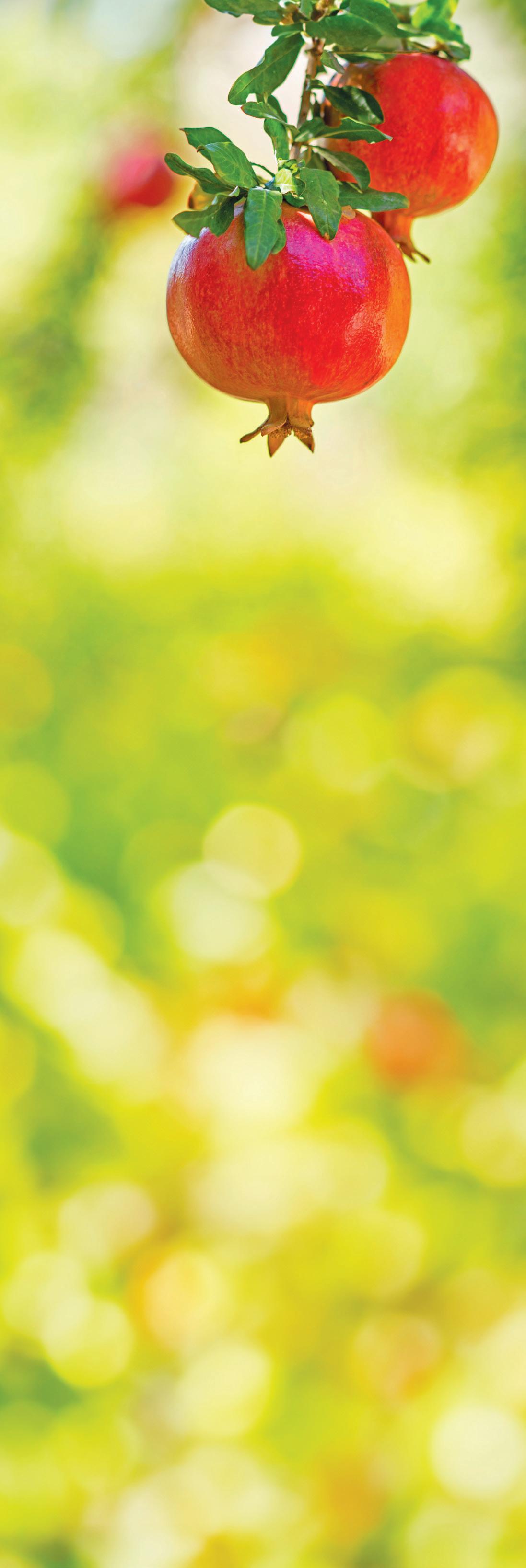
EdibleVenturaCounty.com
Or sometimes: “You know yesterday I had the most incredible dish … But nothing is like the corvina I had at Pablo Neruda’s house …” She went on to share the parties she attended at the famous poet’s home, drinking pisco sours and lots of wine.
Christina Berke is a writer and educator from the Conejo Valley. She’s currently working on a novel. Visit ChristinaBerke.com to learn more.
Artichokes • Arugula • Beets • Broccoli • Brussels Sprouts Cabbages • Carrots • Chard • Celery • Garlic • Kale Lettuces • Onions • Radicchio Spinach • Winter Squashes
EATING BANANA BLOSSOMS
An excerpt from No Meat Required
 BY ALICIA KENNEDY
BY ALICIA KENNEDY

This morning I learned how to clean banana blossoms to ready them for cooking. You peel off the thick purple outer leaves to reveal tiny yellow flowers beneath, which are removed and put to the side. Once all the little flowers have been removed, it’s time to remove the stamen and calyx from each. These parts are inedible. With the smallest flowers, though, the ones that grow closest to the heart, nothing need be done; there’s no stamen or calyx. Once cleaned up, the remaining yellow flowers are put into a bowl of water with the juice of a lime, which keeps them from oxidizing and turning completely brown. Then they get dried off and cooked, maybe into a stir-fry or a curry, perhaps a fritter in a spiced batter. I hadn’t listened to my friend from Tamil Nadu, in India, who told me to grease my hands or wear gloves while going through this process, and now my thumbnails are stained black. I’ve learned a lesson about following instructions.
I’d never cooked or eaten banana blossoms before. They’re traditional to South and Southeast Asia, as well as South America—in Costa Rica, a picadillo de chira de guineo (chira de guineo meaning “banana flower”) is eaten with tortillas. Here in Puerto Rico, where I live, I haven’t heard of them being used, despite how ubiquitous bananas are both in the terrain and in the cuisine. That we can eat these banana
46 FALL 2023 Edible Ojai & Ventura County EDIBLE Excerpt
Photo courtesy of Beacon Press
blossoms feels so exciting to me. Finding food where I didn’t know it existed: This is a gift that being vegetarian has given to me. I don’t think I would have seen banana blossoms as edible before choosing to give up meat, because I was born an omnivore on Long Island. Being a vegetarian food writer, though, and moving around the world, making friends wherever they may be, has made gastronomy and ecology open up to me like a banana blossom, revealing layers upon layers of beauty where I hadn’t known to look for it.
There is so much diversity in the natural world that has been stamped out by agribusiness and its force-feeding of a meat-based Standard American Diet upon the population of the United States, a diet which like a disease has spread further around the world through neocolonialism and cultural imperialism. This is a book about claiming biodiversity and rebuilding the food system in a way that supports culture, tradition, and gastronomy. This is a book about what it means to remove meat from the center of our plates: If we do that, what do we find?
The United Nations’ International Panel on Climate Change (IPCC) told us in August of 2021 that a warming of 1.5 degrees Celsius is inevitable—but that we have time to change industrial structures to pre- vent more warming. In 2020, in a special report titled Climate Change and Land, the IPCC told us that the food system is a major cause of global warming—attributable for 21–37 percent of total greenhouse gas emissions—and that all of us, every human, should move toward a plant-based diet rather than a meatbased one. It’s been clear for over 50 years that the way land is used for farming—80 percent of farmed land is used to grow feed for livestock, which provides only 18 percent of the world’s calories supply and 37 percent of its protein supply—is inefficient. This inefficient monoculture, as the cultivation of single crops is known, has dire consequences for our global ecosystem, global hunger and health, and the animals and insects whose robust existence is complementary to our human one.
Because the inefficiency of this way of growing and consuming food has been known for so long, many people decided to change how they eat in order to get a head start on a rapidly encroaching future in which meat must
return to its old status as a luxury good, in which dairy must come from different sources and not just cows, and in which eggs aren’t laid by hens in tiny cages and male chicks aren’t sent down chutes to die. A world in which animals aren’t confined to factory farming operations and fed genetically modified corn, then processed by underpaid and overworked meat-processing workers, is a different world than what we in the United States have become accustomed to, of course. Luckily, these people who’ve gotten a head start on eating for a different future have laid the groundwork for thinking through what that world looks like—that world where we don’t have a meat-based diet.
I don’t care about meat. That should be said sooner rather than later. Eating meat is the default in Western cultures. What is compelling about making the default decision? Nothing, at least not to me. Jacques Derrida called the conditions for being understood as a full subject in the West “carnophallogocentrism”: being a meat-eater, being a man, and being an authoritative, speaking self. I’m only one of these, but I can be authoritative, and I can be loud.
I’m concerned with the alternative choices, the abstentions and refusals. Sometimes the alternative choices are rooted in ethical or spiritual foundations. Other times, political. These political foundations could be anarchist or fascist or anything in between.
Basically, there is more diversity of thought in the refusal of meat than in meateating by default, both as a way of thinking and in the diet itself. The diversity of thought and of diet are complementary; they feed off each other, support each other—the good and the bad. The delicious and the disgusting.
I believe there is in the recent history of meat refusal a way forward in our rapidly warming world. But it’s all complicated, a history populated by a range of characters, a range of ideologies. Here, in this book, I will attempt to make sense of them.
This excerpt from No Meat Required: The Cultural History and Culinary Future of Plant-Based Eating by Alicia Kennedy (Beacon Press, 2023) is reprinted with permission from Beacon Press.
FALL 2023 47 EdibleVenturaCounty.com
Being a vegetarian food writer and moving around the world, making friends wherever they may be, has made gastronomy and ecology open up to me like a banana blossom, revealing layers upon layers of beauty where I hadn’t known to look for it.



FALL 2023 49 EdibleVenturaCounty.com
’SHROOM SERVICE
Exploring the diversity of nature with mushrooms
BY ROBIN GOLDSTEIN PHOTOS BY TAMI CHU
Ifind few ingredients as exciting and delicious to cook as mushrooms. Whether wild or cultivated, exotic or the more common varieties, mushrooms are relatively easy to cook and add a unique umami flavor and texture to recipes.

Mushroom experts tell me that mushroom cultivation is a comparatively low-impact, lowresource form of food production. Most mushrooms growers use a regenerative approach that encourages biodiversity and topsoil health, which in turn produces healthy nutrient-dense foods.
Mushroom varieties number in the thousands, but only about 20 are commercially cultivated. I prefer picking my own at the farmers’ market or from bulk bins in grocery stores, versus prepackaged. And I always choose whole over sliced. I look for dry (not slimy) mushrooms that are plump and springy with firm, blemish-free exteriors. Plasticwrapped mushrooms are to be avoided unless the plastic is vented. I always store mushrooms loosely covered with room to aerate. While it’s OK to wash whole mushrooms like cremini, portabella, chanterelles or domestic white mushrooms right before cooking, they can absorb water like a sponge, so we chefs will gently clean them with a soft brush to remove any visible debris or dirt.
ROBIN’S Recipes
Chef Robin Goldstein’s cooking career has been centered in California, where she has been preparing
foods
for 30+
years.
She brings to the table a deep-felt art of balancing flavors while interacting with her private clients in their homes. She shares her
delicious recipes
through her popular cookbooks, perfectly paired for those who seek savory Mediterranean-inspired flavors. PrivateChefRobin.com
SIMMERED LEMONY MUSHROOMS
The simplest way to cook mushrooms is simply simmering them with dry white wine or sherry, vegetable or mushroom broth, then adding garlic, fresh herbs and seasonings. These are delicious added to risotto or as an accompaniment to grilled meat.
Serves 4
2 tablespoons olive oil
6 cups mixed mushrooms, hand torn into large pieces (Crimini, Shiitake, wild mushrooms)
2 tablespoons dry white wine or sherry
¼ cup vegetable or mushroom broth, or water
4 cloves garlic, minced
2 sprigs lemon thyme, chopped
1–2 tablespoons fresh lemon juice
1 tablespoon butter
Salt, to taste (start with about 1 teaspoon)
Freshly ground black pepper
Heat a large skillet over medium-high, add olive oil and mushrooms. Gently stir until the mushrooms have released their liquid and wilted slightly. Add white wine or sherry and broth and cook about 10 minutes more, until all the liquid evaporates and the mushroom edges are lightly golden brown.
Add minced garlic and cook another minute or two.
Remove from heat and season with thyme, lemon juice, butter, salt and freshly ground black pepper, tossing to melt the butter.
MUSHROOMS SHAWARMA
Sautéing or roasting mushrooms at high temperatures yields savory, umami flavors that mimic smoked meats as in my Mushroom Shawarma recipe below. The taste is pleasantly earthy with ethnic spices. Makes about 3 cups
2 pounds sliced Lion’s Mane or King Trumpet mushrooms
Spice Blend (make ahead)
1 tablespoons sea salt
½ tablespoon freshly ground pepper
2 tablespoons ground cumin
2 tablespoons paprika
2 teaspoon ground turmeric
1 tablespoons ground ginger
1 tablespoon minced garlic
½ tablespoon ground cinnamon
½ teaspoon allspice
Pinch cayenne, or more if you like spicy
Put all spices in a bowl and mix until well blended.
Toss the sliced mushrooms with ¼ cup of the spice blend until all mushrooms are coated. Add more to coat generously, using your fingers to rub the seasoning gently into the mushrooms.
If grilling, thread mushrooms onto bamboo or metal skewers (about 4–5 per skewer). Repeat until all mushrooms are skewered.
If roasting, simply spread the seasoned mushrooms on a parchment-lined baking sheet. Load your skewered mushrooms onto a preheated grill or put the baking sheet into a 400°F oven. Grill until all sides turn brown or roast for about 30 minutes.
To serve, load your roasted mushrooms onto warm flatbreads with hummus, finely sliced radishes and cucumber and chopped tomatoes—tossed with a pinch of salt—and top with fresh mint and/or cilantro.

EdibleVenturaCounty.com
VENTURA COUNTY FARMERS’ MARKETS

WEDNESDAYS
Midtown Ventura
Certified Farmers’ Market
Pacific View Mall
(West End Parking Lot)
3301 N. Main St.
Wednesdays, 9am–1pm (rain or shine)
VCCFM.org
805-529-6266
THURSDAYS
Downtown Oxnard
Certified Farmers’ Market
Plaza Park, 5th St. & B St.
Thursdays, 9am–1:30pm (rain or shine)
OxnardFarmersMarket.com
805-247-0197
Ojai Community Farmers’ Market
Chaparral Courtyard
414 E. Ojai Ave.
Thursdays, 3pm–7pm
OjaiCommunityFarmersMarket.com
661-491-0257
Thousand Oaks
Certified Farmers’ Market
The Oaks Shopping Center
(East End Parking Lot)
Wilbur Rd. & Oaks Mall Dr.
Thursdays, noon–5pm (rain or shine)
VCCFM.org
805-529-6266
FRIDAYS
Santa Paula
Certified Farmers’ Market
Santa Paula Train Depot, 200 N. 10th St.
Fridays 3pm–7pm
EnrichedFarms.com
Simi Valley
Certified Farmers’ Market
Civic Center Plaza
2757 Tapo Canyon Rd.
Fridays, 11am–3:30pm (rain or shine)
Facebook.com/SimiValleyMarket
805-643-6458
SATURDAYS
Agoura Hills
At Whizen Market Square
28914 Roadside Dr. Saturdays, 9am–2pm @ccfminc
Camarillo Hospice
Certified Farmers’ Market
2220 Ventura Blvd., Old Town
Saturdays, 8am–noon (rain or shine)
CamarilloFarmersMarket.com
805-987-3347
Downtown Ventura
Certified Farmers’ Market
200 Block of Main St.
From Palm to Mission Park
Saturdays, 8:30am–noon (rain or shine)
VCCFM.org
805-529-6266
SUNDAYS
Ojai
Certified Farmers’ Market
Behind the Arcade
300 E. Matilija St.
Sundays, 9am–1pm (rain or shine)
OjaiCertifiedFarmersMarket.com
805-698-5555
Moorpark
Certified Farmers’ Market
450 High St.
Sundays, 9am–2pm
EnrichedFarms.com
818-699-6204
Community Market
At Oxnard College
Campus Parking Lot
Sundays 8am–3pm
Maria_olivares2@my.vcccd.edu
Channel Islands Harbor
Farmers’ Market
Marine Emporium Landing
3350 S. Harbor Blvd., Oxnard
Sundays, 10am–2pm (rain or shine)
RawInspiration.org
818-591-8161
Westlake Village
Farmers’ Market
2797 Agoura Rd.
Sundays, 10am–2pm (rain or shine)
RawInspiration.org
818-591-8161
WEEKENDS
Ventura College Foundation
Weekend Marketplace
Ventura College East Parking Lot
Corner of Telegraph Rd. & Day Rd.
Saturdays & Sundays, 8am–2pm VenturaCollegeFoundation.org
Note: All info was updated in August 2023. As details do change, please contact the markets and CSAs for the latest info.
52 FALL 2023 Edible Ojai & Ventura County
WINE • BEER • FOOD
Since 1984
JohnNicholsGallery.com
Vintage, Vernacular and Contemporary Photographs
Custom Archival Framing
Featuring artisan wine and craft beer by-the-glass or bottle. Creative food menu and gourmet Panini. Serving lunch and dinner.
WINE CLUB DISCOUNTS

WINE TASTING THUR-SUN
BOTTLE SHOP, WINE BAR & CHEESE MARKET
HOURS
Monday Closed | Tue/Wed 12–7PM
Thur/Fri/Sat 12–9PM | Sunday 12–5PM

LOCATED
117 N. 10th St., Santa Paula
Hours: By Appointment or by Chance
Phone: 805-501-7011
make friends, share coffee, go to the beach!


ragamuffinroasters.com


2423 Ventura Blvd., Camarillo, CA 93010 (805) 383-9812 | wineclosetinc.com


FALL 2023 53 EdibleVenturaCounty.com
“Seed/Signal” by John Nichols
WINE • BEER • FOOD
Located above the Santa Paula Art Museum
IN NEWBURY PARK & OXNARD
VENTURA
The Cave Restaurant & Ventura Wine Co.

Ojai & Ventura County
Local Guide to Good Eats & Drinks
Please visit our advertisers and let them know you appreciate their support of Edible Ojai & Ventura County. They enable us to offer this magazine free of charge to readers throughout Ventura County.
All Things Tea

European teahouse with certified Tea Specialist. Specialty loose-leaf teas from the finest plantations and gardens around the world. Cream Tea, Afternoon Tea and High Tea.
In Paseo Camarillo Center | 300 N. Lantana St., #37 | Camarillo | 805-445-8327 | Tea-Liteful.com
The Wine Closet
Wine lounge in Old Town Camarillo, featuring unique wines, craft beers, small plates, lunch and dinner. Weekly happy hours and featured wine tastings. Indoor and outdoor seating. The specialty market offers retail sales of fine wines, craft brews, artisan cheeses and charcuterie. 2423 Ventura Blvd. | Camarillo | 805-746-5708 | WineClosetInc.com
Sip, Dine, Shop, Wine Taste. Full Service Restaurant. 40 Wines by the Taste or Glass. Retail Wine Shop. Wine Club

4435 McGrath St., Ste. 301 | Ventura | 805-642-9449 | TheCaveVentura.com
Crave Gelato Kofi Bar

Ventura Harbor’s coffee and dessert bar with premium organic coffee, lattes and curated cold-brews, handcrafted plant-based gelato and even pup-cups.
947 Schooler Dr. Suite 105, Ventura | 805-918-0553 | GelatoKofiBar.com
Paradise Pantry

Food with a local emphasis, including great sandwiches, salads, mac ‘n’ cheese, gourmet goodies, a cheese counter and an extensive wine shop. Diners can also enjoy craft beers, wines by the glass or wine flights.

222 E. Main St. | Ventura | 805-641-9440 | ParadisePantry.com
Poseidon Brewing Company

A small, local, veteran-owned craft brewery making a variety of beer styles. Visit the tasting room or take a growler to go.
5777 Olivas Park Dr., Ste. Q | Ventura | 805-477-0239 | PoseidonBrewingCo.com
Ventura Spirits

Since 2011, using the natural and agricultural bounty of California’s Central Coast to hand craft novel and delicious spirits.
3891 N. Ventura Ave. | Ventura | 805-232-4313 | VenturaSpirits.com
OJAI
Boccali Vineyards & Winery
Boccali Vineyards is a family owned and operated winery with a tasting room located right next to Boccali’s Pizza & Pasta.
3277 E. Ojai Ave. | Ojai | 805-669-8688 | BoccaliVineyards.com

Edible Ojai & Ventura County
edible
CAMARILLO
Create your own unforgetable experiences at Ox and Ocean with a private wine pairing dinner.
FILLMORE
SANTA PAULA SIMI VALLEY
Anna’s
Ciders and Santa Paula Brewing Co.
Hard Cider Tasting Room in Downtown Santa Paula. Familyowned craft cider company producing dry & refreshing ciders. We serve food on our outdoor patio and are family friendly.
801 E. Main St. | Santa Paula | AnnasCider.com.
CONEJO VALLEY
Onyx at Four Seasons

Westlake
A seasonally inspired Japanese focused menu featuring Nigiri sushi and sashimi at a sit-down sushi bar. Menu includes traditional hot items and an impressive sake selection.
2 Dole Dr. | Westlake Village | 818-575-3044 FourSeasons.com/westlakevillage/dining/restaurants/ onyx_restaurant.
NEWBURY PARK/OXNARD
Ox & Ocean
Tying into the unique makeup of California, Ox & Ocean serves locally sourced produce and seafood fresh from Oxnard’s plains and sea, celebrating a diverse influence and distinct flavors in an elegant, yet approachable fashion.

2101 Mandalay Beach Rd. | Oxnard | 805-984-2500 | OxandOcean.com.
Roan Mills Bakery

California’s first land-to-loaf bakery, Roan Mills grows the wheat, mills the flour, bakes the bread and makes the pasta. Stop in at their bakery in historic downtown Fillmore and taste the difference.
411 Central Ave. | Fillmore | RoanMills.com
Nectar of the Dogs Wine

Brand new wine tasting room on the west end of Simi Valley. Wines sourced locally in California with a portion of sales donated to local nonprofit dog rescue organizations.
791 Chambers Ln., Ste. 110 | Simi Valley 702-275-0482 | NectaroftheDogsWine.com


CATERING
NABU Wines

A member of the Malibu Coast wine trail, NABU makes wine from Napa Valley to the Malibu Coast. Live music and wine tasting every Saturday & Sunday noon–6pm.
2649 Townsgate Rd. | Westlake Village | 818-835-3704 | NabuWines.com

Private Chef Robin

Robin Goldstein is a California chef who works her culinary magic combining unique flavors and seasonal ingredients with classic techniques inspired by her extensive travel around the Mediterranean.
PrivateChefRobin.com

PORT HUENEME
Ragamuffin Coffee Roasters

Family owned and operated coffee shop and bakery with ethically sourced coffee, gluten-free pastries and excellent service.

111 N. Reino Rd. | Newbury Park 805-375-9000 | 550 Collection Blvd., Ste. 130 | Oxnard | 805-278-5837 | RagamuffinRoasters.com
La Playa Soul
Family-owned restaurant serving SoCal-Soul. Southern inspired menu, incorporating Mexican spices & California fresh ingredients. Handcrafted biscuits served alongside specialty lattes.
419 E. Port Hueneme Rd. | Port Hueneme | 805-874-1177 | LaPlayaSoul.com

FALL 2023 55 EdibleVenturaCounty.com
Endless Summer
A truly local cocktail to celebrate the extended summer weather in VC
RECIPE BY IZUMI HAMAGAKI
Editor’s note: This cocktail was created for and served at our Summer magazine launch party. It got such rave reviews from attendees that we decided to share it here. Cheers to an extended summer season!
Makes 1 cocktail
2 large strawberries, quartered
½ ounce honey syrup (recipe below)
½ ounce ginger juice (we used Ginger People)
Juice of ½ lemon
1½ ounce Opuntia (Ventura Spirits)
¼ ounce Amaro Angeleno (Ventura Spirits)
1–2 ounces Guava Citra Hard Kombucha (Flying Embers)
Add strawberries, honey syrup and ginger juice to a cocktail shaker and muddle well. Add lemon juice, Opuntia and Amaro to the shaker, then fill with ice. Close with lid or shaker pint and shake well. Strain mixture into a highball or rocks glass over cube ice and top off with Guava Citra Hard Kombucha.

Options: Add a strawberry or lemon wedge as a garnish. Serve immediately.
Honey Syrup
½ cup local honey (we used Bennett’s Honey)
½ cup water
In a small saucepan, simmer honey and water over medium-low heat until honey is dissolved, stirring regularly. Allow to cool before using. Store in a glass jar in the fridge for up to 3 weeks.
As Creator and “Mixtress” of Radical Botanicals, Izumi Hamagaki develops innovative beverage concepts using plants, herbs, fruits and flowers to alchemize natural ingredients into complex, intentional and functional elixirs. She is currently launching her line of wine-based ultra-premium canned cocktails, 21ROCS, and is excited to share them with the world.
LAST Sip
Photo by Tami Chu
56 FALL 2023 Edible Ojai & Ventura County


THE 10th NATIONAL HEIRLOOM EXPOSITION Celebrate a world of flavor! Sept. 12-14, 2023 Ventura Co. Fairgrounds, Ventura, CA TheHeirloomExpo.com
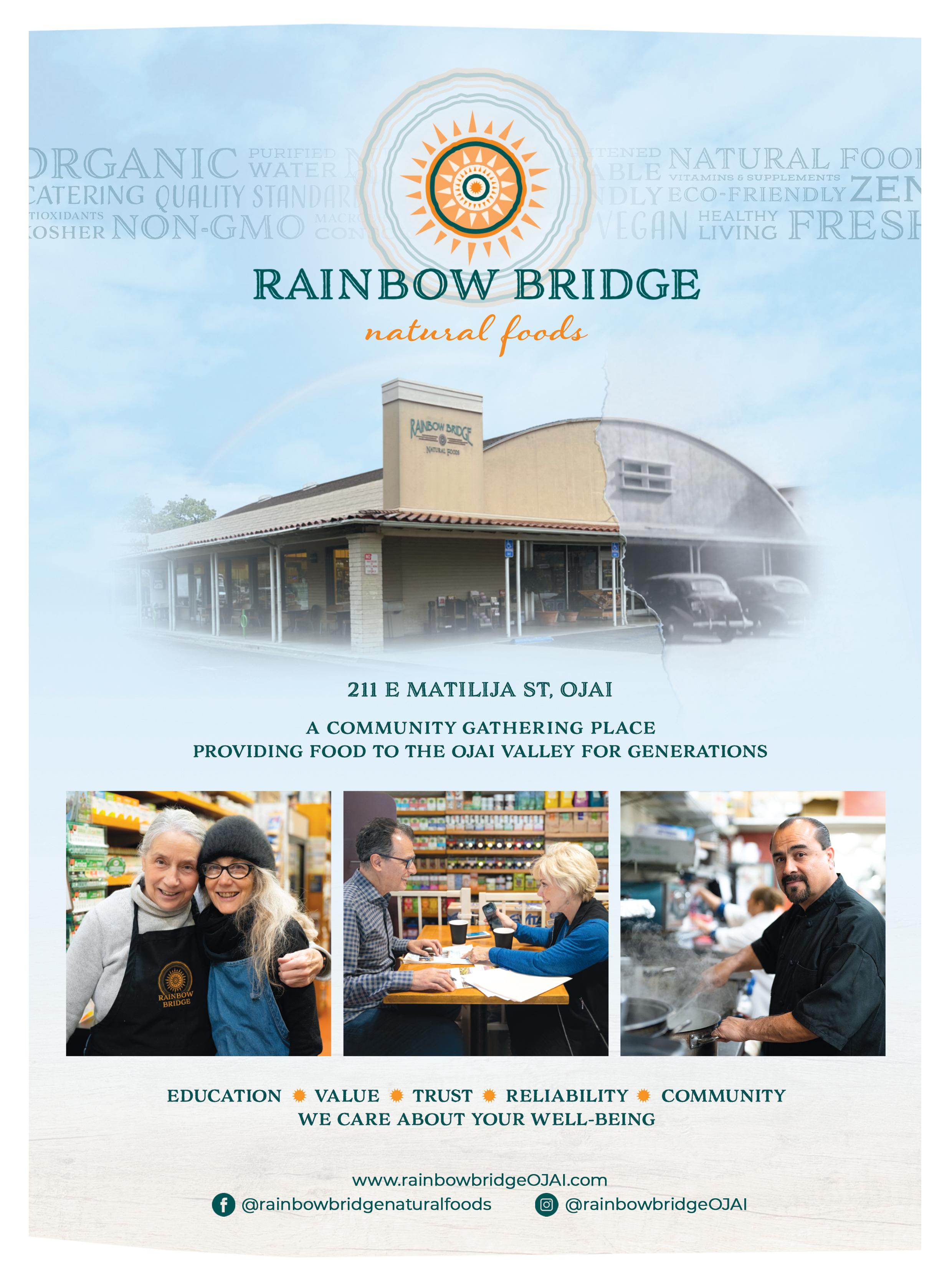





















 ADAM HART
ADAM HART



















































































































 —Elizabeth Whitlow
—Elizabeth Whitlow


























 BY ALICIA KENNEDY
BY ALICIA KENNEDY







































